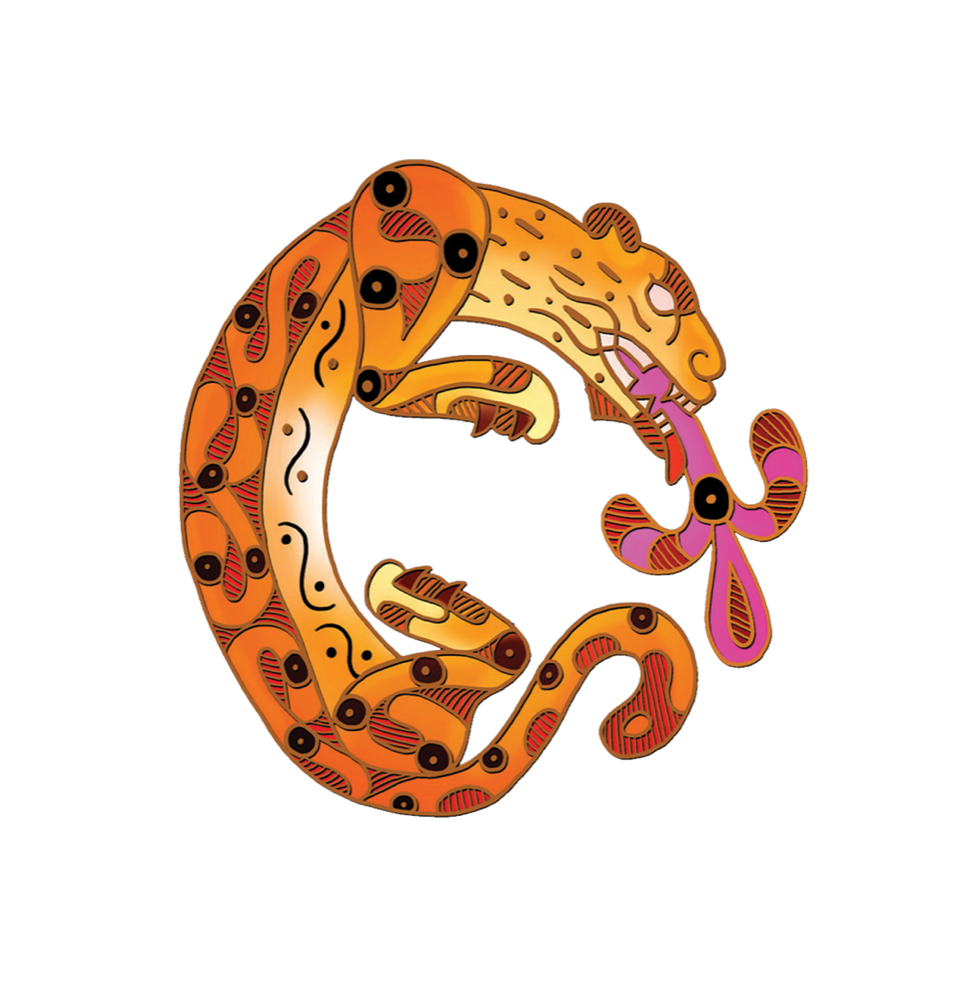

“NJP stands out as an organization working to protect big cats, not only by preserving valuable habitat, but by transforming the way people interact with jaguars.” – Review on GreatNonprofits.org
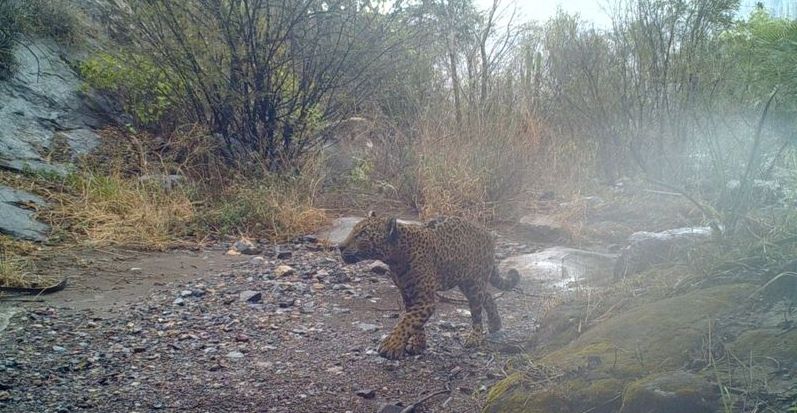
Long live the Queen… the Queen of the Northern Jaguar Reserve, Libélula… March 28, 2024
As the vibrant colors of spring begin to blossom around us, we reflect on the profound impact that each season brings to our lives and those we serve. Today, we want to commemorate with you the life and legacy of a beloved member of our organization, the amazing jaguar Libélula, who graced the Northern Jaguar Reserve and surrounding Viviendo con Felinos ® ranches with her presence for more than eleven years. Your support made her long life possible.
Read More
Libélula (Spanish for “dragonfly”) was first recorded on the Dubaral creek in the central part of the Northern Jaguar Reserve in April 2012. Soon after, together with a male (“Ferb”), she became the first female jaguar to be video recorded as a pair by our motion triggered cameras. This encounter with Ferb, which produced several pictures and videos during April and May of that year, is the beginning of our association with the life story of this incredible creature that we came to know as Libélula. One of the pictures from that time, taken together with Ferb, was used on the cover page of the Jaguar Recovery Plan published by the U.S. Fish and Wildlife Service. Libélula’s association with Ferb resulted in a pregnancy, which means that Libélula was at least two years old at the time. During the following months, through our cameras we were able to track the signs of pregnancy and lactation, and on February 2013 we were treated to a photo of the first of her cubs, “Pedro,” to be born since we began tracking her. Pedro was named in honor of Peter Warshall, one of the NJP’s founders.
There were several records of Libélula, running through December of that year. Back then, the Viviendo con Felinos ® program was much smaller than today, and it’s possible that Libélula simply moved for several months to one of the ranches that was not part of the program. We got a few more recorded shots of her in October 2014, but then she disappeared for several years, not reappearing until 2017.
When she resurfaced on the reserve and in some of our Viviendo con Felinos ® ranches, she seems to have been raising a cub until about February 2018. The small cub was never captured in a photo, but a full-grown jaguar called Tito who showed up in a later photo might have been her cub.
In 2019 Libélula was recorded on several Viviendo con Felinos ® ranches, some of which were new to the program that year. During that year, she also visited several other parts of the Northern Jaguar Reserve, including Los Pavos (the first ranch bought to establish the reserve and currently on its northern edge), Babisal, Dubaral and Las Tézotas. In early 2020 there was a new encounter with a male recorded by our cameras. Guapo is most likely the father of the cub that was born later that year, and that was first recorded in October 2020. Angel became the first cub that was recorded on the same image as its mother and also the first cub to have been recorded several times between his first appearance and April 2021.
After Angel disappeared from our cameras (hopefully because he grew independent), Libélula was recorded again in September 2021, now displaying mating behavior with Compa. This was on the Bábaco ranch at the southwestern edge of the reserve. By that time, she had been known to us for nine years and five months, which means that she was at least 11 years, 5 months old. This encounter did not result in a pregnancy, since there were later signs of males being close to her, and even other encounters recorded with Compa (October 2021) and Don Julio (March 2022). In September 2022 we got some photos showing her in apparent lactation, but a cub was never seen. Later pictures – taken in November with just a few hours difference from the one with Don Julio – show her now with no clear signs of lactation.
Starting in December 2022, Libélula was recorded on several Viviendo con Felinos ® ranches and once on Bábaco. Unfortunately, in September 2023 the first pictures of a declining jaguar were the early announcement that Libélula was not doing well. When in December we received the report from a Viviendo con Felinos ® rancher that his cowboy had found a dead ocelot or jaguar (Libélula was already known to the team to be “chaparrita”, meaning a smaller animal in comparison to other jaguars), it was not a stretch to think that it could be her. The pictures sent soon after by the cowboy left no doubt: Libélula’s distinctive patterns were clearly recognizable.
Libélula remains our most photographed and video-recorded jaguar. Eleven years and six months passed between the first photo taken April 27, 2012, and the last from November 4, 2023. During this time, we know with certainty of the existence of two of her cubs: Pedro and Angel, although there might have been other pregnancies as well.
In a recent meeting with the Viviendo con Felinos ® ranchers, we explained the importance of Libélula as part of our monitoring efforts and the circumstances of her death. The owner of the ranch where her body was found, said, “Yes, she is the Queen of the Northern Jaguar Reserve, and she will be forever our Queen. Long live the Queen of the Northern Jaguar Reserve”.
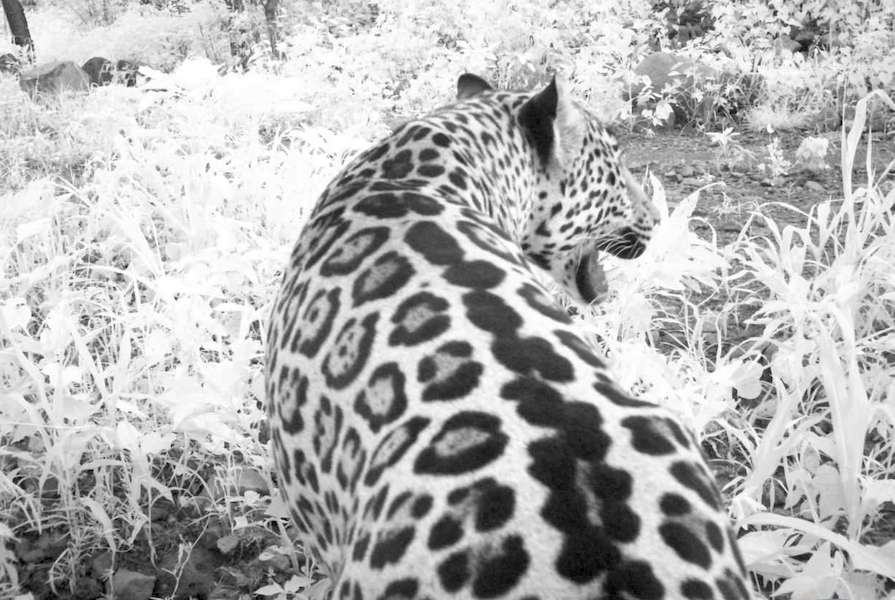
The Land is Fresh and Renewed October 8, 2021
After experiencing more than a year of severe drought that caused losses of cattle, crops, and livelihood, we are delighted to report that a generous monsoon began in mid-summer. Within weeks, rains had converted the Northern Jaguar Reserve into a lush jungle of vibrant green foliage. Creeks are flowing again, waterholes across the ranches are full, the jaguars and other felids are thriving, and we have exciting news to share.
Read More
Please join us in welcoming Roberto Wolf Webels as our new executive director. Roberto has extensive leadership experience in conservation issues across Mexico and is poised to help us write the next chapter and deepen relationships with partners across the country. An animal lover since childhood and trained as a veterinarian, Roberto previously worked with the Mexican gray wolf reintroduction in northern Mexico. He has experience with Mexican zoos and government agencies, including SEMARNAT (Mexico’s federal wildlife agency) and CONANP (Mexico’s commission for natural protected areas).
The footprint of our Viviendo con Felinos project continues to grow with the enrollment of Rancho Cieneguitas. This ranch is important because it is part of a large ejido with multiple ranches and owners. Ejidos are the mainstay of Mexico’s cooperative ranching and farming system and provide the opportunity to reach more individuals and families than single-owner private ranches. We have already retrieved photos of a jaguar roaming the ejido.
We are pleased to report that we assisted two ranch owners to obtain compensation through the Seguro Ganadero (nationwide cattle growers insurance) following recent cattle depredations that were attributed to feral dogs and coyotes.
We continue to work with the Borderlands Linkages Initiative to identify critical wildlife corridors between private and government reserves. This project is in collaboration with Wildlands Network, Nature and Culture International, Profauna, Cuenca Los Ojos, Sky Island Alliance, and Rancho El Aribabi. As part of this effort, NJP has placed 22 cameras at La Chamada, a 12,350-acre ranch southeast of the Viviendo con Felinos ranches. Our role is also to identify and catalog jaguar photos from all of these locations.
There is More Good News April 6, 2021
Angel is the first cub – of the seven on our cameras to date – that we have captured on video. We have been waiting many years for this glimpse of a cub in motion, and what a gift it is. Libélula and Angel, mothers and their cubs, are the key to survival for all other jaguars in this region. This is the source population that makes the movement of jaguars in Arizona possible, barring any obstructions or walls in their path. Every contribution we receive provides the haven mother jaguars need to raise their young free from harm.
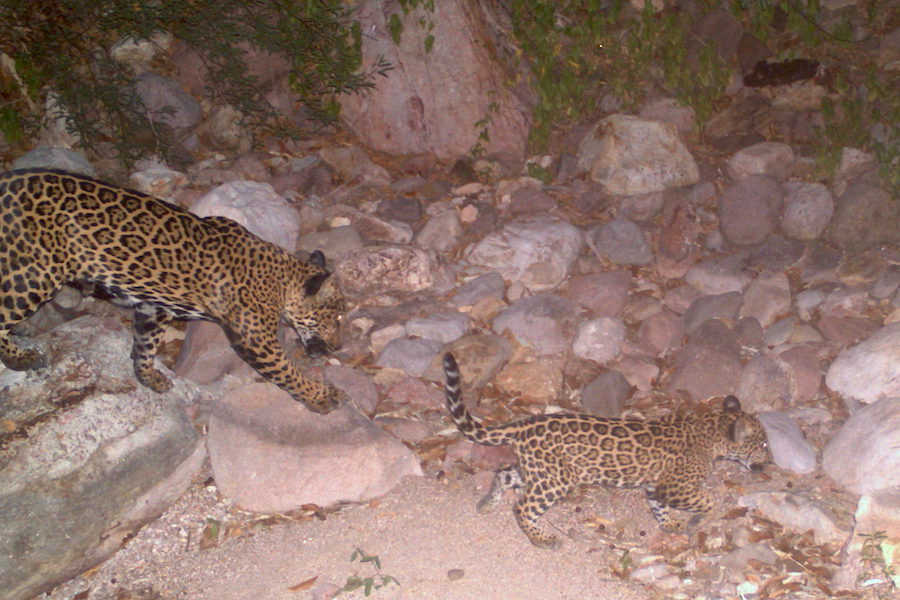
The Newest and Youngest Jaguar Cub April 6, 2021
The first image of the female jaguar Libélula on the Northern Jaguar Reserve was in 2012. She walked over, tail swishing, and smelled the camera. Weeks later, we watched as Libélula and the male jaguar Ferb strolled up and down the same arroyo. Eventually, we saw their cub, Pedro.
Read More
Libélula has been our near-constant companion over these nine years. Her anniversary is in April along with Arizona Gives Day, which is today.
Last year, she delivered big news in time for this day of giving: A series of photos with El Guapo. We spent the summer and fall wondering when we might see their cub. Libélula frequently appeared, but she was always solo. We held out hope, knowing that cub photos are rare.
It was worth the wait! We are thrilled to introduce you to Angel, Libélula’s newest cub. Angel was born on the reserve and is approximately five months old in this photo. Libélula is the oldest-known female in the region, and this tiny jaguar is the youngest.
Please consider supporting this brand new life as part of Arizona Gives Day – a one-day campaign to boost support for Arizona-based nonprofits. Our many thanks for your support!
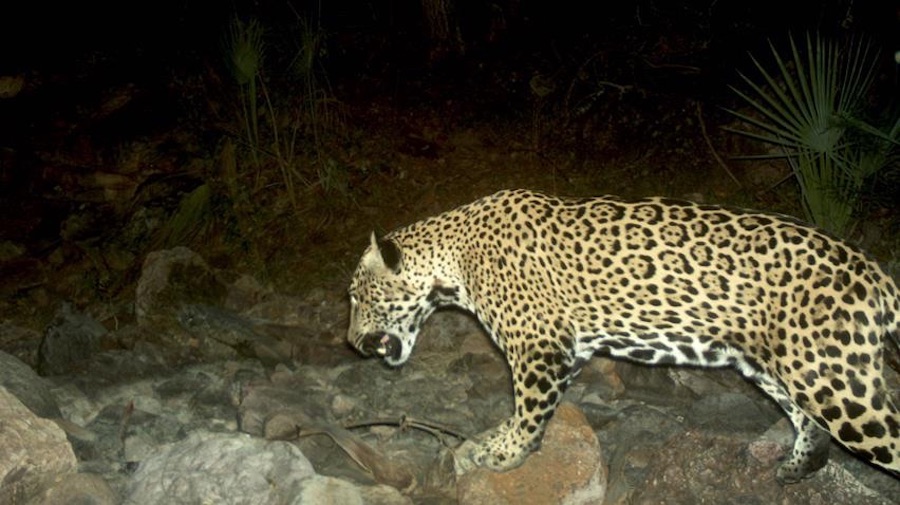
Borderland Jaguars are an Antidote December 11, 2020
All of us are connected by our common interest in the jaguar. We are deeply grateful for the Northern Jaguar Project’s ever-widening circle of supporters and your contributions to protect these cats.
Read More
Over the last year, we recorded 11 jaguars in 150 photos on the 270 square miles of uninterrupted habitat under our care on the Northern Jaguar Reserve and Viviendo con Felinos ranches. This includes new jaguars, old friends, a mating pair, and a mother with her cub. They have provided a much-needed antidote to the events of this year.
ON THE RESERVE: For our field team, the remote, rugged nature of the reserve makes it easy to social distance. They spend each day in a place that is as full of life as ever – evidenced by the vibrant plant communities, animal encounters, and the images retrieved from motion-triggered cameras.
We explored and relocated cameras to some hard-to-reach areas this year. Our most important results extend to the smaller cats. An ocelot we first saw a decade ago continues to roam these lands. Photos of three other ocelots date back nearly as long.
ON THE RANCHES: The cats and reach of Viviendo con Felinos have grown in tandem with one another. We enrolled a new ranch this year and have plans to incorporate a ranch that had a depredation, thereby reducing tensions toward jaguars.
We have provided economic incentives for more than 1,100 feline photos, making this the highest single-year result for Viviendo con Felinos – with jaguars on 10 ranches. One ranch, after a handful of years with no jaguar sightings, had photos of three individuals in three months.
IN TOWN: We engage youth to foster an appreciation for living wildlife. We adjusted this year to create at-home activities for those Eco-Guardians with internet access. We distributed free activity books via a local grocery store to connect kids with the outdoors. And we painted jaguar-themed murals in four Sonoran towns to increase visibility among a wider audience. One of these is on a cattleman’s association building, a visual metaphor for coexistence.
We want to thank you for making our work possible. We are primarily funded by individual donations, and your contributions are essential to protect jaguars and this dazzling habitat. Please consider a year-end donation today and help create a resilient future for these endangered cats. We are inspired by and grateful for each and every one of you.
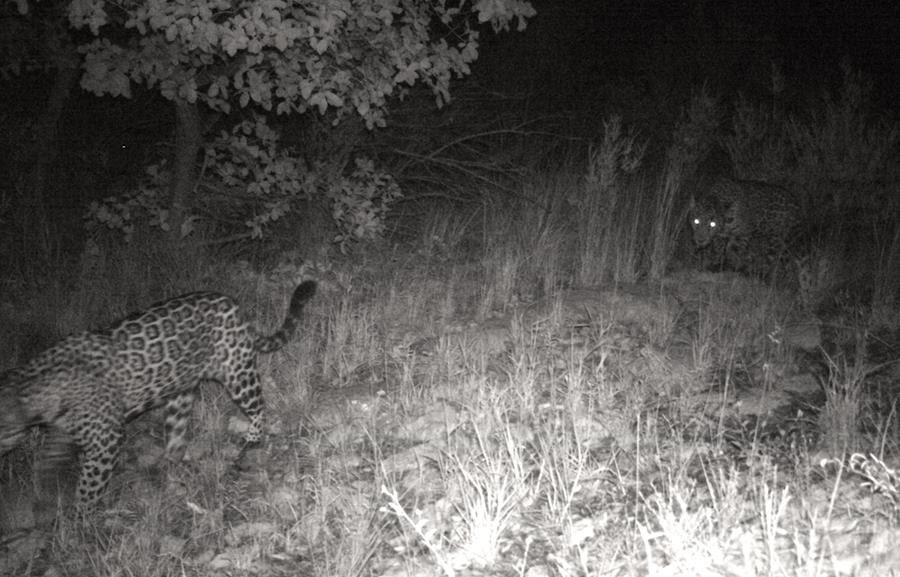
Show Your Jaguar Love Today December 1, 2020
Our research coordinator Carmina Gutiérrez asks: “Are you sitting down?” Carmina has said this enough over the years, we already know there is something new and exciting on the Northern Jaguar Reserve’s motion-triggered cameras. This time, it is a photo with an intriguing second pair of eyes.
Read More
The jaguar on the left is Luisa, a female we had not photographed since 2018. We were thrilled for her return, and more because the jaguar trailing behind is her cub, Choki.
This sighting is what we always hope for. It illustrates that the reserve is a birthplace and sanctuary, and shows the impact this protected area has for the future of jaguars in their northern range.
We have photographed 11 different jaguars on the reserve and Viviendo con Felinos ranches this year. Among these are four new individuals: Choki, Mickey, and two others as-yet unnamed.
The most recent jaguar photos were taken only one week ago and feature Libélula. Libélula has appeared on the reserve for more than 8.5 years. She is now the longest-documented jaguar on our cameras and the longest-recorded female in this region. Everyone on our team works extra hard to protect her.
Libélula started the year in photos with El Guapo. This “handsome” male has been seen across every season, so regularly that we have a few camera locations he appears to have claimed ownership of.
Today is Giving Tuesday. Your contributions help safeguard each of the jaguars on our cameras, as we plan upcoming reserve expansion and continued growth of our Viviendo con Felinos project.
The challenges of this pandemic year have been a steady reminder of how important it is to support nonprofit organizations. We appreciate everyone who helps us continue our mission to protect the world’s northernmost jaguar population and the natural habitats where these big cats reside.
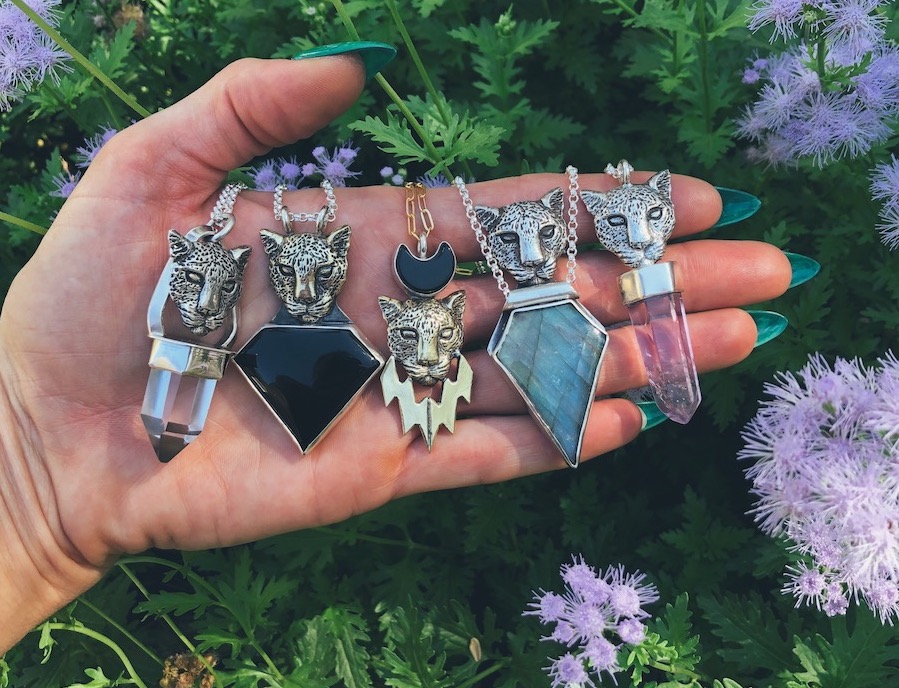
Support NJP with Handcrafted Jewelry October 16, 2020
The mighty jaguar is celebrated in a new collection of jewelry handcrafted in Tucson by Heliotrope artist Spring Winders: Bolo ties, earrings, necklaces, rings, and one-of-a-kind pieces. Fans describe wearing Heliotrope’s jewelry as symbols of their relationship with and love for the Sonoran Desert. We are happy to announce that thanks to a new partnership, 15% of sales will be donated to NJP. Check out Heliotrope’s Jaguar Collection here.
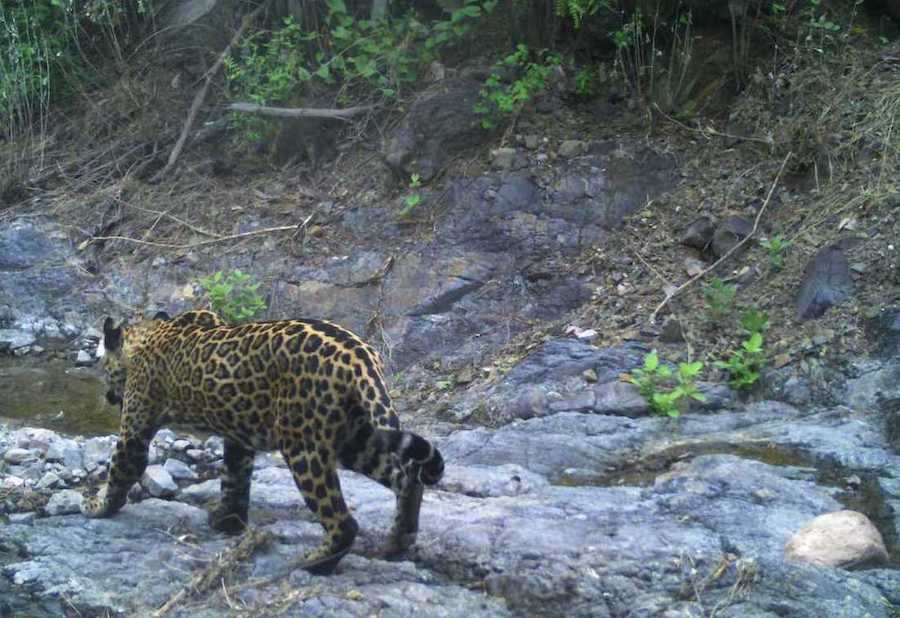
Building a Stronghold for Jaguars September 24, 2020
Because you helped us create a safe haven for jaguars, and you keep us going despite a world in the midst of so much upheaval, we want to share how deeply we value your support. So far this year, we have photographed 10 different individuals on the Northern Jaguar Reserve and neighboring Viviendo con Felinos ranches. The real stars are old friends: Suki, Libélula, Zapatos, El Guapo.
Read More
We are building a stronghold for jaguars. Females like Suki and Libélula are the most essential members of the population. They are the key to survival for all other jaguars in this region, and real-time evidence of our positive impact, as we witness critical habitat and jaguar corridors being dynamited along the U.S.-Mexico border.
We are focused on where we have proven we can make a difference. The Northern Jaguar Reserve is the best home we could possibly have right now. Those of us who work out on the reserve feel the power and resiliency of the jaguar as we continue to protect them each day. This includes patrolling the reserve to keep poachers out.
Some areas of our recent work:
• We continue to check cameras each month and pay feline photo awards.
• We enrolled a new ranch in Viviendo con Felinos, expanding the geographic reach.
• We designed virtual activities to engage a core group of youth Eco-Guardians.
• We expect a land acquisition opportunity on the horizon once pandemic restrictions are lifted.
• We are advancing steps to purchase property and establish a permanent headquarters.
We have approached these uncertain times by weaving tighter bonds within our team, staying productive with good results, and trusting that you know how much we appreciate every single donation. Whatever life has brought you this year, we hold you in our thoughts and send our best wishes from the place where jaguars roam. We thank you for your generosity.
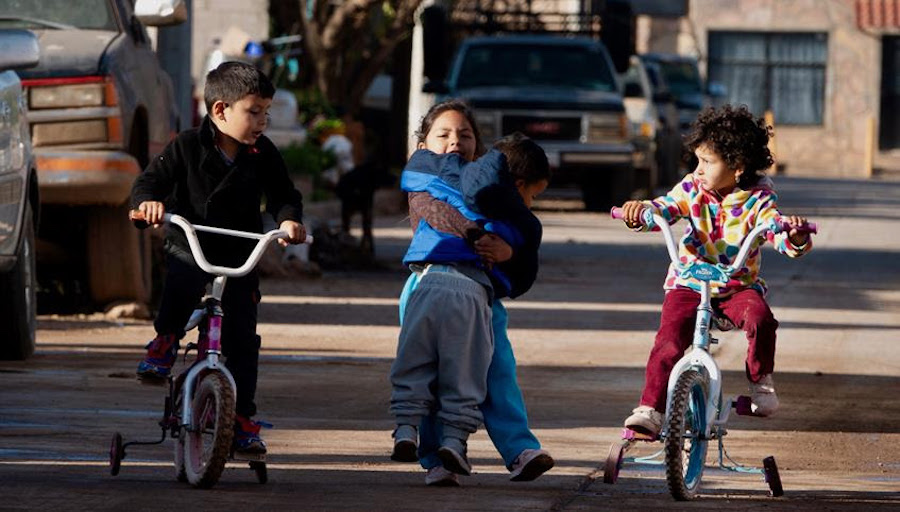
A Ray of Sunshine on AZ Gives Day April 7, 2020
As all facets of society are challenged, we believe wilderness and wild places can be a balm. The Northern Jaguar Reserve will always be at our core; everything else radiates out from there. Our field team is tenacious and continues to patrol the reserve to deter poachers and trespassers.
Read More
They maintain 200 motion-triggered cameras on the reserve and Viviendo con Felinos ranches. The newest images provide a source of inspiration.
Libélula will celebrate her eight-year anniversary on our cameras later this month, taking the reins as the oldest-known female jaguar in this region. Our team puts in long hours, motivated to ensure her survival.
The male jaguar El Guapo with Libélula were together earlier this year, and we are expecting the patter of tiny paws soon. While the world may feel upside down, new life continues on the reserve.
Maybe this is the ray of sunshine you need today. Today is Arizona Gives Day, and we have been considering what sets us apart: our field staff, Libélula, and the safe places she needs to raise a cub. We appreciate your kindness, steadfast support, and donations at this critical time.
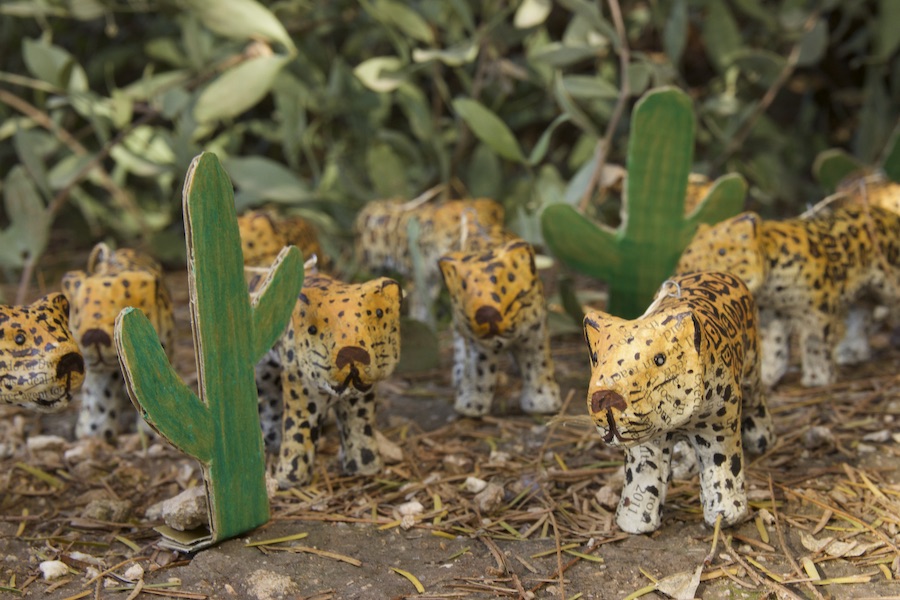
This has been a Year of Jaguars December 3, 2019
WINTER: A new jaguar appeared in photos on the Northern Jaguar Reserve. We named him Zapatos. We soon learned cameras across Sonora had seen him before. Thanks to these images, we know he is the second-oldest jaguar in this region at 11 years.
Read More
SPRING: A female jaguar Libélula reached her seven-year anniversary on our motion-triggered cameras. We responded by expanding our Viviendo con Felinos project with three new ranches so we could protect more of the places Libélula roams.
SUMMER: We saw Suki with her newest cub on one of the Viviendo con Felinos ranches. The rancher was so proud to have the pair on his property, he named the cub after his own nickname, El Chetuviri.
FALL: A new photograph of Libélula signaled that she is now the longest recorded jaguar on our cameras, having surpassed the beloved Corazón who was tragically killed in 2014.
Each of these cats is significant. Older, resilient jaguars like Zapatos, long-term residents like Libélula and Suki, and baby jaguars like El Chetuviri illustrate the impact our work is having for the northern jaguar population.
We continue steps to expand the reserve; we also understand jaguars will always wander beyond its boundaries. This year, Viviendo con Felinos grew to safeguard 150 square miles of the buffer zone adjacent to the reserve. The reserve offers protection for an additional 86 square miles.
Our staff has also grown this year to accommodate this larger area and increase our community involvement. Some favorite recent activities: a kids’ campout on the reserve, a jaguar mural on the cattleman’s association building, and a festive Viviendo con Felinos celebration for more than 200 residents.
Our achievements can only continue with your support. Your contributions on Giving Tuesday help Zapatos, Libélula, Suki, El Chetuviri, and all the other jaguars on our cameras this year. Please help us kick off our year-end season of giving with a tax-deductible donation today.
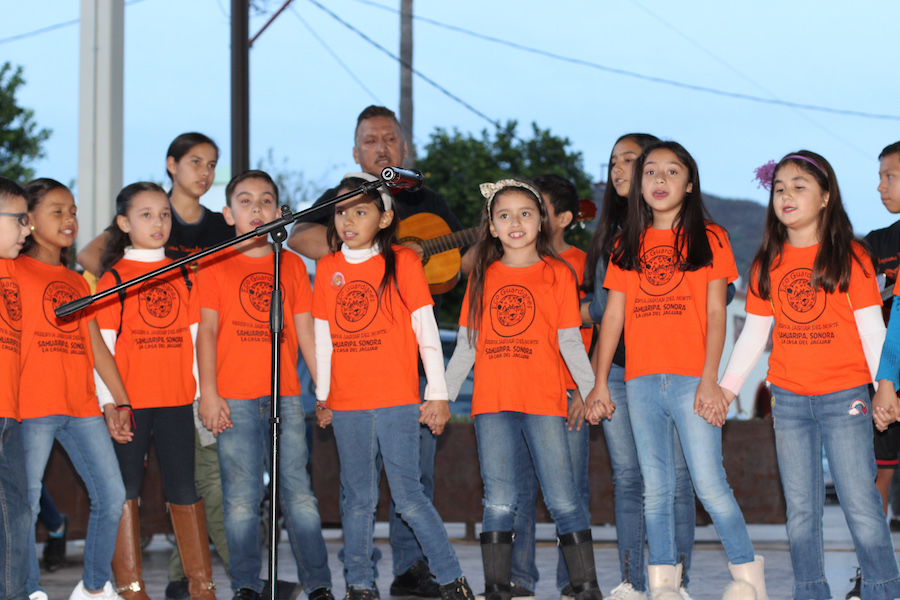
Celebrating Living with Cats November 29, 2019
We celebrated International Jaguar Day in Sahuaripa last weekend with our annual Viviendo con Felinos fiesta and photography exhibit. The community gathered to honor participating ranchers and award a prize for the year’s best feline photo.
Read More
The judging was a nearly impossible task: a mother jaguar with cub, a cat with battle wounds across its chest, a mountain lion mid-pounce, a jaguar walking straight toward the camera. No one could guess who the judges would pick.
Ultimately, a night-time photo of the female jaguar Suki was selected. Moments before the winner was announced, the ranch owner discussed plans to put a new pond on his property. He won a large water trough and was thrilled.
Viviendo con Felinos has changed the ranchers’ lives and the lives of cats who roam here. With three new ranches added in 2019, the total protected buffer zone outside the Northern Jaguar Reserve now covers an impressive 150 square miles.
We see this growth reflected in a record number of jaguar and feline images. We see it in the outpouring of support at events like this fiesta and in the popularity of our Eco-Guardian club. Kids filled the town plaza playing games like pin the tail on the jaguar. They painted each other’s faces, sang songs, and recited jaguar poetry. We raffled bikes donated by the Tucson-based Bicycle Inter-Community Art and Salvage (BICAS). And the winner of a jaguar drawing contest will have their work painted as a mural.
This event was FESTIVE! There is a noticeable sense of pride, cooperation, joy, and appreciation that is developing in this community. Parents come to us with comments such as “Bless you for all that you have done.”
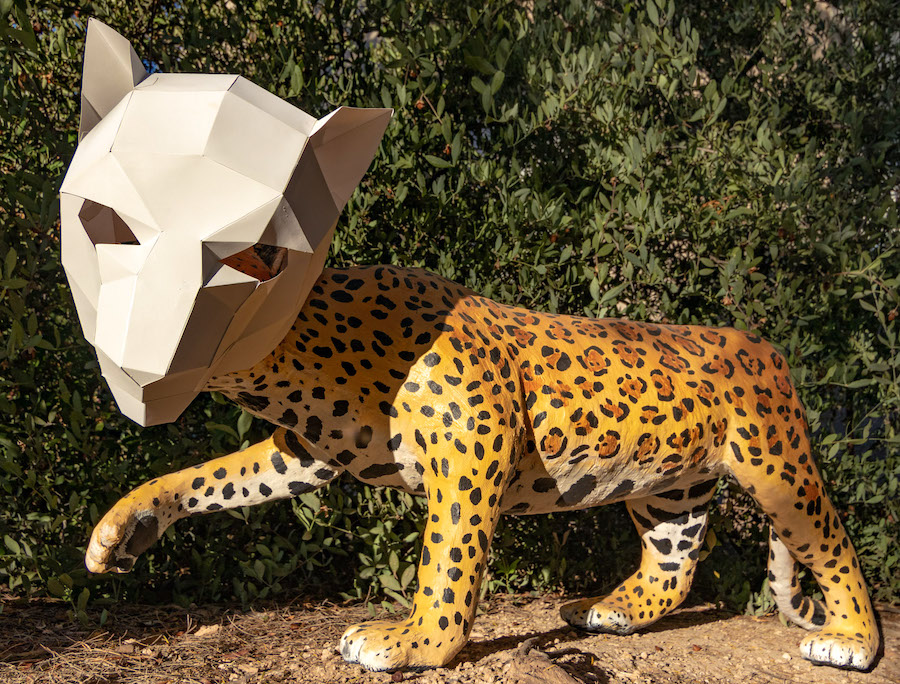
Jaguar Mask-making Workshop October 2, 2019
Ten years ago, we made papier-mâché jaguar masks for Tucson’s All Souls Procession as part of a much larger memorial for the beloved Macho B. In life and death, Macho B provided hope and inspiration – showing the world that jaguars belong here.
Read More
We live in a region where every single jaguar is essential. We do not get to see these cats except through motion-triggered cameras. Over time, we learn from their movements, and they begin to feel familiar. We will never forget when Macho B was killed. Or Corazón. Or Yo’oko last year.
Each jaguar lost is motivation to work harder to protect this endangered population.
We made the Macho B masks at a series of free workshops offered for the community to honor the lives of those who have passed. This year, Many Mouths One Stomach is hosting biweekly workshops leading up to the procession. Each workshop has a different animal theme, and up next is El Tigre.
Tuesday, October 8th, 6:30 – 8:30 p.m.
FREE and you get to keep your mask!
MSA Annex, 267 S Avenida del Convento, Tucson, AZ
Supplies and instruction will be provided to create an easy cut-and-fold cardboard mask. Workshops continue every Tuesday and Thursday throughout the month.
Wear your creation on October 26th at the Animal-Style Masquerade Ball, an evening of art, music, and dance at the MSA Annex, organized by La Tierra del Jaguar. Then bring your mask to walk with us at the All Souls Procession on November 3rd.
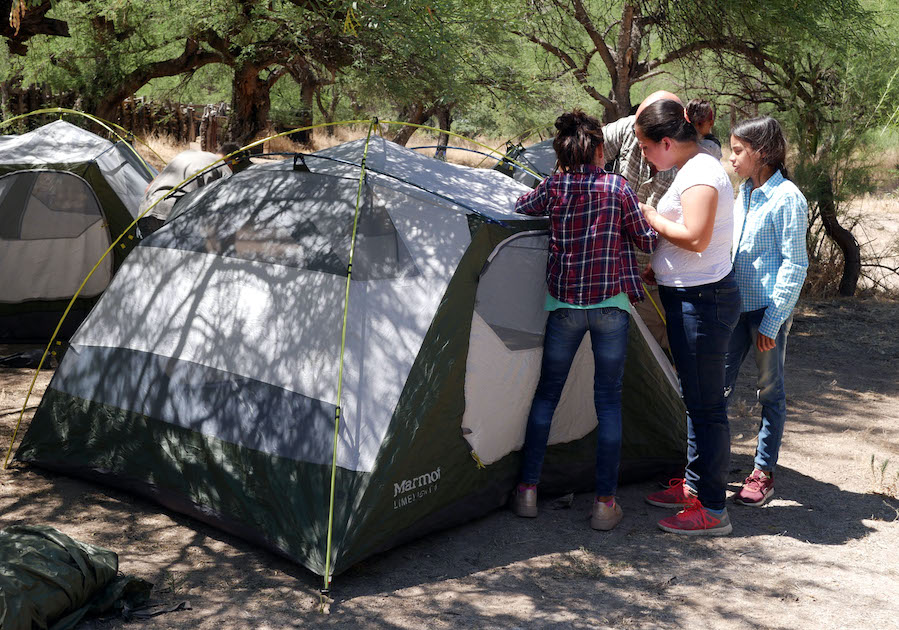
Meet the Eco-Guardians June 11, 2019
We have been getting kids outdoors with nature walks, river cleanups, tree plantings, hands-on camera trainings, and public art projects. It feels like all of those activities were leading up to this past weekend when we took the first group of these kids camping. Can you imagine being 12 years old and going on your first-ever camping experience on the Northern Jaguar Reserve?!
Read More
Even though these youngsters live in the nearest town, the reserve is difficult to reach. The Eco-Guardians played games as we traveled the long, bumpy road. And when we finally arrived, a whole new world opened up.
During the heat of the afternoon, they sat in the shade and made friendship bracelets. At dusk, they went birding and saw trogons, flycatchers, gnatcatchers, hawks, and orioles. In the cool evening hours, they ate s’mores around the campfire. Hours after dark, under a blanket of stars, they went for a hike to set up motion-triggered cameras and discover what animals were nearby.
Seeing the reserve through the kids’ eyes was pure sweetness. They were full of a contagious sense of wonder and amazement. Their laughter was genuine and constant, overflowing with joy to be in this spectacular place.
You could see them come to life on the reserve. These kiddos formed bonds of friendship, developed a love for nature, and were filled with life-defining moments. There is nothing like spending a night out in the wild to feel the excitement of being in a place where jaguars roam.
Hundreds of students participate in our Eco-Guardian club, and we hope this will be the first of many such outings. All of the Eco-Guardians have deep family ties within this community, a place where residents young and old are learning to embrace the jaguar as a friend and neighbor.
Special thanks to the Arizona Trail Association’s Seeds of Stewardship program for the gear loan and to Optics for the Tropics for donating binoculars for just this kind of event.
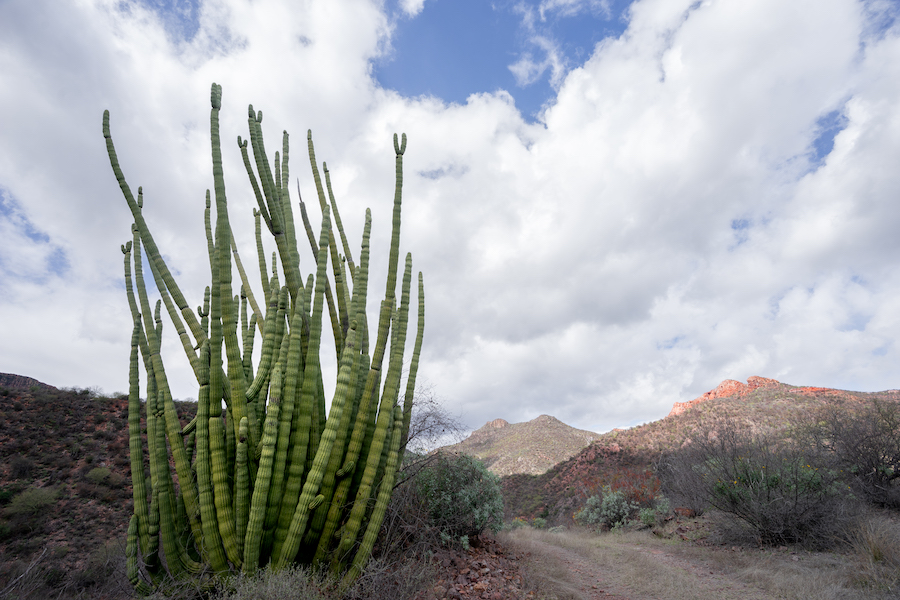
Save the Jaguar on AZ Gives Day April 2, 2019
“I feel my heart expanding.” That is what a first-time visitor said over the weekend as we drove further into the Northern Jaguar Reserve. We were on our way to the Río Aros, where just a few weeks ago we found fresh jaguar prints at water’s edge.
Read More
These tracks could have been left by our longtime friend Elvis, or maybe they were from a new jaguar, Zapatos, who first appeared on the reserve in January. Either way, seeing footprints in the sand and feeling the jaguar’s presence nearby definitely made our hearts grow, just like with our donor when he was introduced to the reserve’s sweeping, panoramic views.
We hope any one of the highlights below will make you feel equally as inspired.
Libélula celebrates seven years on our cameras this month. After having no photos of her since September, we retrieved a photograph of Libélula taken just two weeks ago in a new, distant geographic area we are exploring to learn where jaguars roam.
Valentina and an as-yet-unnamed jaguar are new on the Viviendo con Felinos ranches. We have added two ranches to the project in 2019, which means the area covered by signed rancher agreements not to hunt, poison, or disturb wildlife has significantly grown.
Zapatos was near the boundary of the reserve and a ranch we are now negotiating to purchase. We are actively taking steps to expand the 225 square miles already protected by the reserve and Viviendo con Felinos ranches, including upcoming land acquisitions.
Today, NJP is participating in Arizona Gives Day – a one-day campaign to boost support for Arizona-based nonprofits. We are working with new jaguars, in new places, in time-tested ways. Your contributions make this possible.
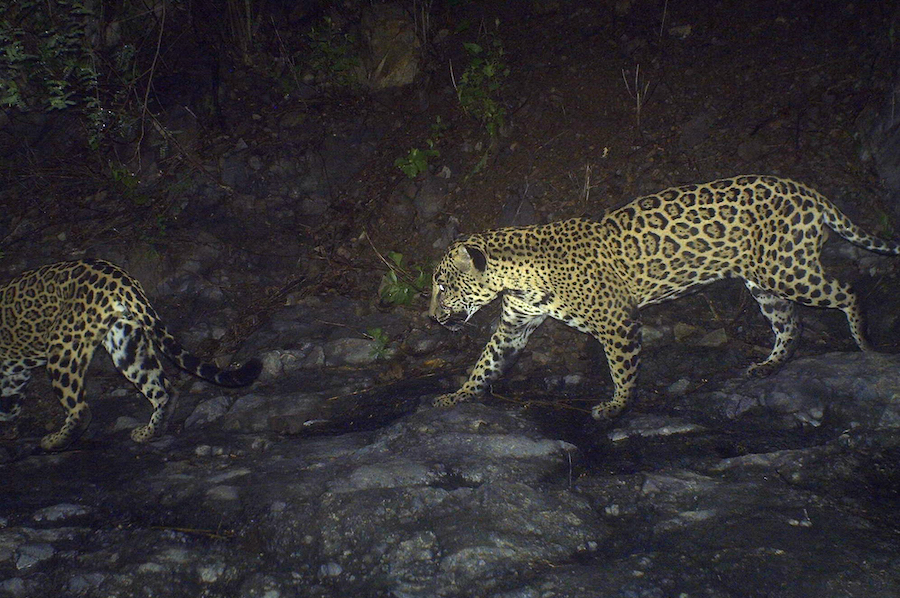
A Great Year for NJP December 31, 2018
What a spectacular year this has been for the Northern Jaguar Project. Our many thanks to our steadfast supporters who have made these accomplishments possible.
Read More
Our Viviendo con Felinos project had unprecedented success this year:
• 76,145 acres protected through signed agreements on 14 ranches.
• 9 jaguars photographed, triple the individuals on these ranches from the year before.
• 5 of the 8 ranches with jaguar photos recorded two or more jaguars.
• $45,000 in photo awards distributed for feline presence.
• 750-acre wildfire extinguished on one ranch thanks to effort led by the reserve’s vaqueros.
• 300 youth participated in hands-on outdoor activities through our Eco-Club.
• 60 young Eco-Guardians trained to select locations and maintain their own cameras.
Four jaguars moved between the Northern Jaguar Reserve and Viviendo con Felinos ranches, including the females Libélula and Suki. That two of our longest-recorded jaguars have found safe homes on working Viviendo con Felinos ranches shows how important our approach is.
More highlights: We photographed a pair of jaguars in February and filmed these same two jaguars mating in March. This was our second video of jaguars mating on the reserve. The pair, Luisa and Elvis, were together again in July.
Fifteen years into this project, we are making a real difference for northern jaguars. Let’s celebrate this anniversary together. All of your donations go directly toward protecting these magnificent cats. As always, many thanks for your support.
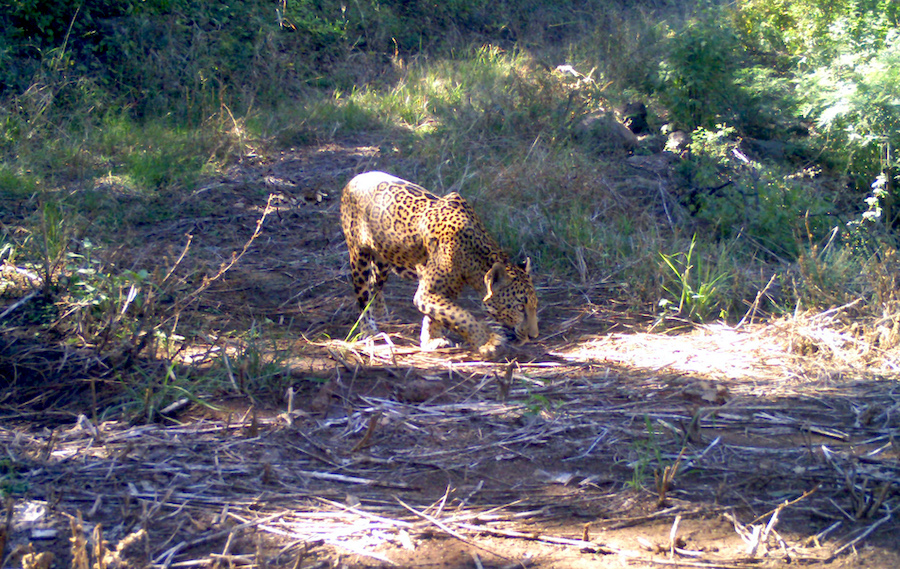
International Jaguar Day November 29, 2018
Today is the first-ever International Jaguar Day. We were thinking of sharing another jaguar photo taken at the cave we posted about earlier this week. A second option was a brand new video of a pair of jaguars on the Northern Jaguar Reserve.
Read More
Then our field assistant Laqui returned to town with the latest batch of photos from the Viviendo con Felinos ranches, including a female jaguar on a ranch that is a haven for mothers and cubs. The ranch owner has said low cattle depredation, combined with income from multiple jaguar photos, means he does not need to travel north for undocumented work in the U.S.
Viviendo con Felinos has changed the ranchers’ lives and the lives of cats who roam here. We need your support so it continues to do so.
Last month, the same rancher won the grand prize at our annual Viviendo con Felinos celebration with a photo of Suki, one of our long-term resident females. He won a solar-powered generator, but the pride he felt from this recognition was perhaps more significant.
We interpret a new jaguar arriving on International Jaguar Day as a good sign. It is also the perfect opportunity to say thank you to everyone who donated so generously on Giving Tuesday. Your support makes Viviendo con Felinos possible.
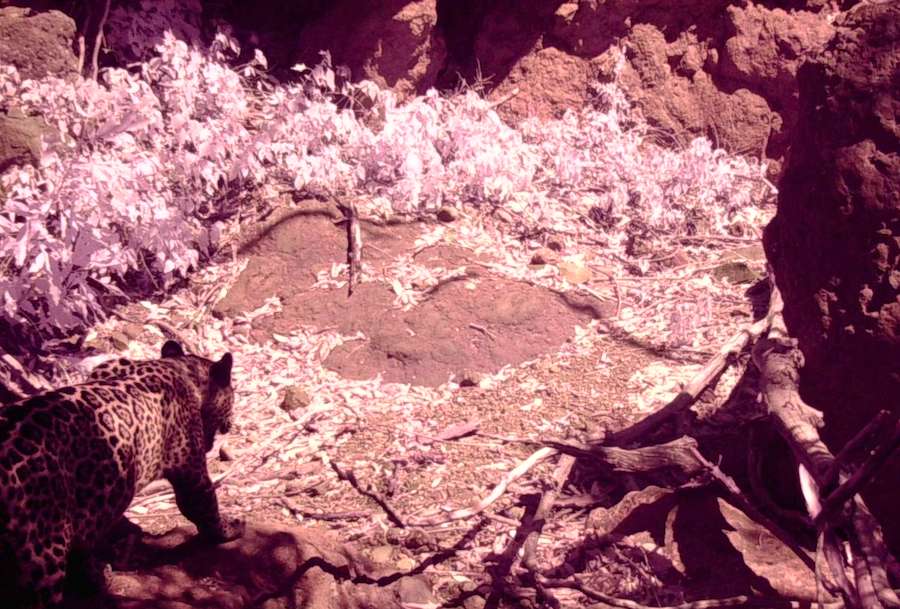
Support the Jaguar on Giving Tuesday November 27, 2018
As part of Giving Tuesday, your contributions help reduce hostilities during a time with increased feline presence. Your gifts matter for Libélula, her cubs, new jaguars, and old friends.
Read More
With your support this year:
• We signed protective agreements with 14 ranchers across 76,145 total acres.
• We photographed nine jaguars on eight Viviendo con Felinos ranches – triple the individuals and quadruple the jaguar photos on these ranches compared to the previous year.
• We had four Viviendo con Felinos ranches with multiple jaguars, both new individuals and long-term residents.
• We recorded the highest number of ocelot and mountain lion photos in a single year.
• We distributed $45,000 in incentives to promote the presence of living wildlife.
• We assisted ranchers with restoration projects and organized activities to get youth out into nature.
• We documented mating jaguars on the Northern Jaguar Reserve.
• We surpassed 1,000 total jaguar photos to date.
Our goal is to have 100 people contribute during this global day of giving. That is ambitious for our small organization and starts with you. Please help us kick off our year-end season of giving with a tax-deductible donation today. Any donation amount is appreciated and guaranteed to have a big impact.
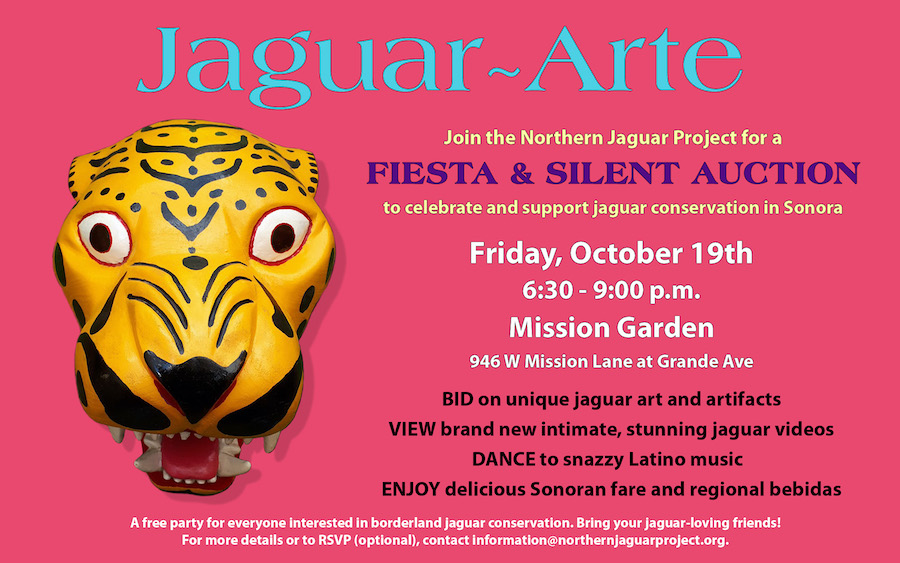
Jaguar-Arte in Tucson September 23, 2018
Fiesta and silent auction to celebrate and support jaguar conservation in Sonora. Bid on unique jaguar art and artifacts, view brand new and stunning jaguar videos, dance to snazzy Latino music, and enjoy delicious Sonoran fare and regional bebidas.
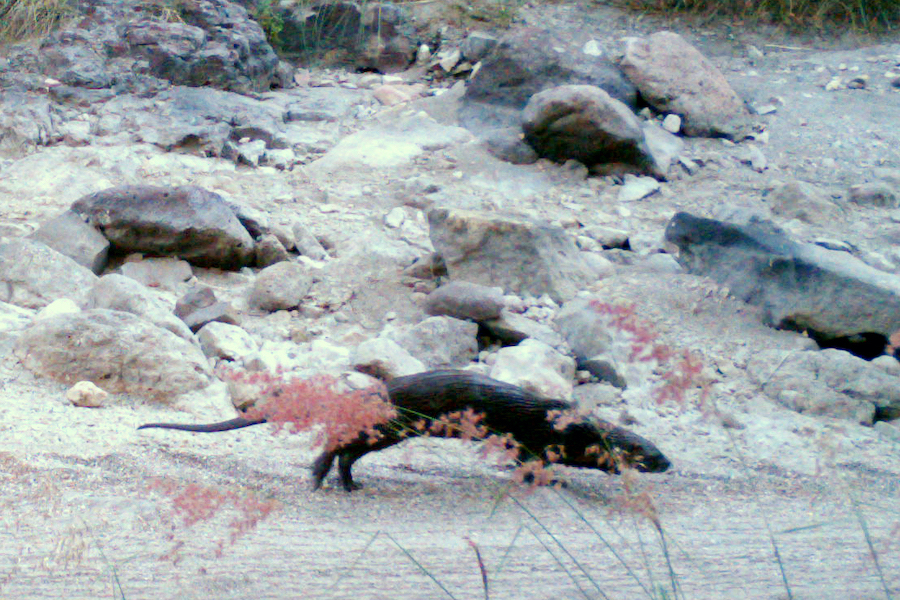
Otter Caught on Camera September 22, 2018
The elder vaqueros tell stories of seeing otters running through the arroyos on the Northern Jaguar Reserve. This is our first motion-triggered photo of a Neotropical river otter in all of our years of camera monitoring. And it was taken nearly four miles from the river! The chance of encountering one of these rare critters clearly still exists around every bend.
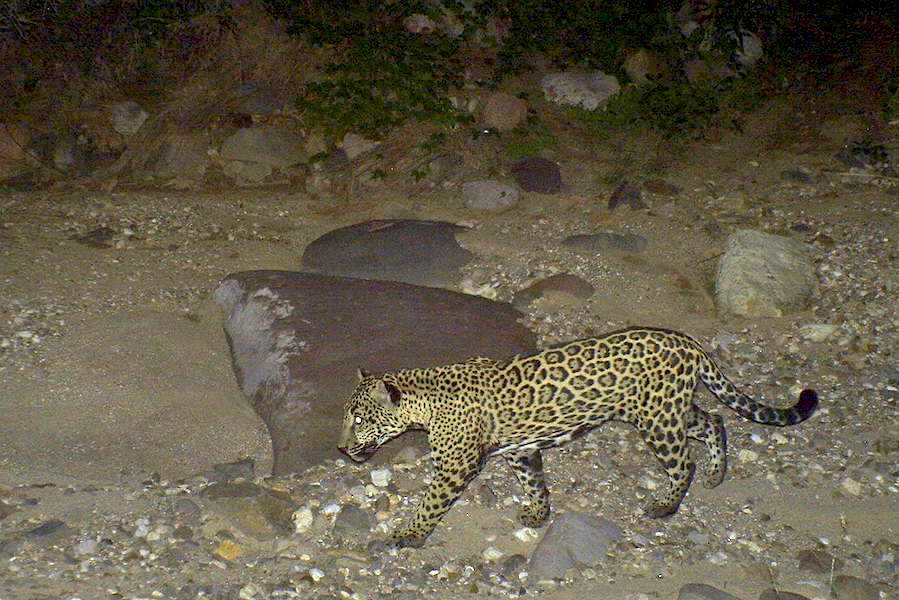
Elvis Turns Five September 21, 2018
This is Elvis. The above photo is the first image of him on the Northern Jaguar Reserve. It was taken five years ago today. While Elvis already held the title as our longest-recorded male jaguar, we are excited to reach this milestone anniversary.
Read More
Elvis’ story is fascinating. We had two photos of him in September 2013. Then he was not seen for more than two years. He re-appeared sporadically in 2016, followed by another yearlong gap.
Everything changed last December. Since then, we have had more than 90 photos and videos of Elvis throughout the Viviendo con Felinos ranches and across the entirety of the Northern Jaguar Reserve.
Elvis has contributed to a record number of jaguar photos this year, a thrilling trend we hope continues. Keeping track of individuals, their movements, and interactions with one another has felt like a telenovela with four female characters and this male lead ironically named after “the King.”
Libélula and Suki are the matriarchs. At six years, they are tied as the second-longest female jaguars on our cameras. Their recent hanging bellies suggest both may have cubs. Sofia is new on the scene. Elvis quickly picked up her scent and trailed her by days on one of the Viviendo con Felinos ranches.
Luisa and Elvis weaved in and out of each other’s paths for months; they eventually appeared together near a place we call “Kitty City.” Later, our cameras filmed Luisa and Elvis mating.
This was our second behind-the-scenes view. Another seemingly impossible jaguar mating video five years ago was considered one in a million – until it was not. Clearly our cameras are well placed, providing us with eyes into the jaguar’s world.
That Elvis reached this five-year anniversary, along with the mating video, illustrates the value of your donations. Our most heartfelt thanks for all you have done to help save the lives of new jaguars and old friends.
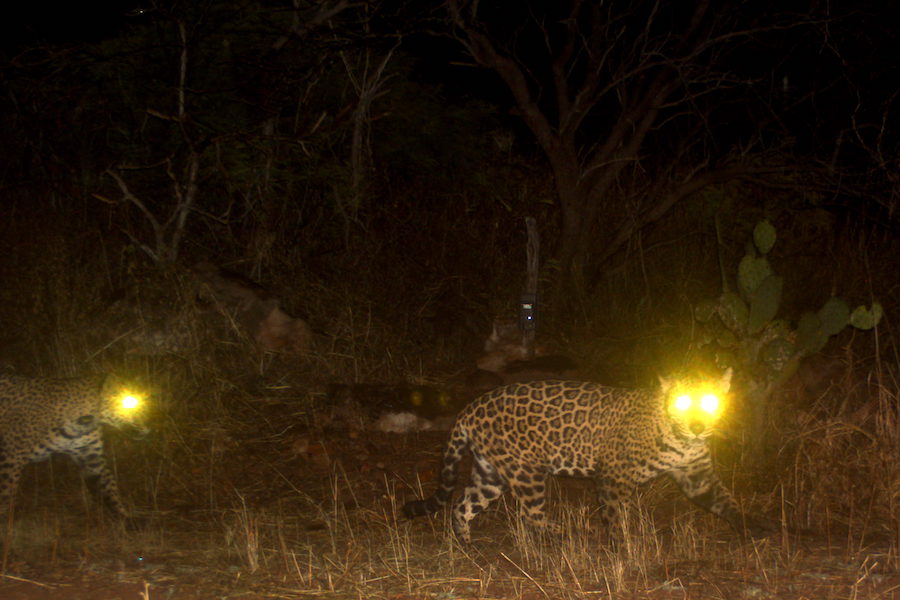
Rare Jaguar Mating Video May 18, 2018
Can a video of two jaguars be considered too risqué to share? We definitely had that conversation with the first jaguar mating video we collected on the Northern Jaguar Reserve in 2013. We never dreamed there would be a second video that again revealed jaguars mating on our motion-triggered cameras in the wild.
Read More
At the beginning of this year, Luisa and Elvis were photographed on the same camera a few weeks apart. In February, they appeared together in the same photograph, which led us to expect a cub. At the end of March, our motion-triggered cameras filmed them mating, and now we are pretty certain there will be a young jaguar roaming the reserve later this year.
This is the reserve’s continuing love story. This is the place we come back to for perspective on how our focus to protect female jaguars and their cubs is both meaningful and essential for this population’s future. This video tells us we are headed in the right direction.
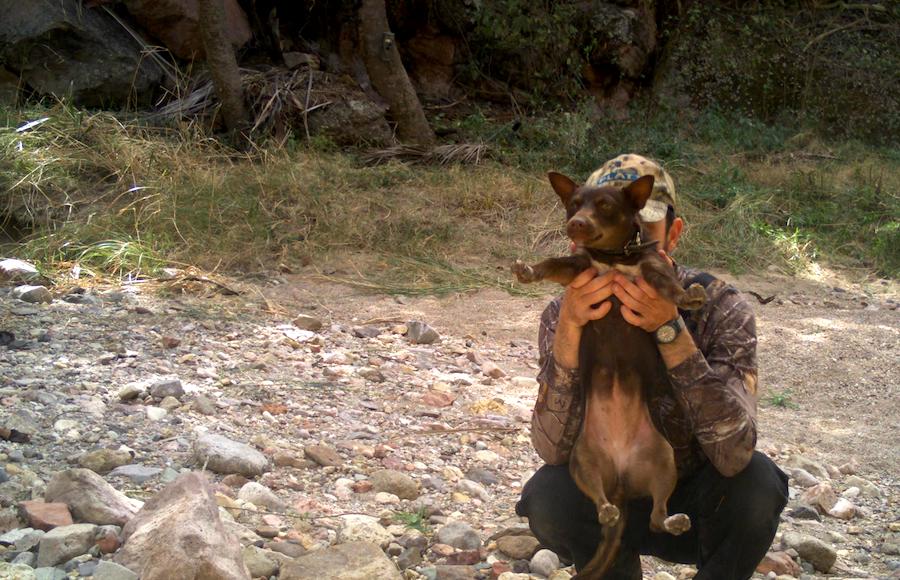
Volunteering on the Reserve April 21, 2018
As an intern of the Northern Jaguar Project, I found myself invited into a wilderness that defies expectation, and a community that carries the heavy weight of its preservation with rugged devotion.
Read More
Since I left the Northern Jaguar Reserve, I have not stopped envisioning when I might return. I have found myself filling in my friends and family on what I have been up to, and I always look forward to seeing their faces when I tell them I spent two months on a jaguar reserve deep in one of the most remote wilderness areas of Sonora, Mexico. There is usually a short, stunned pause that follows this news along with an abundance of questions that I have on occasion lost my voice trying to answer.
The more I tell these stories, the more I realize they are mostly about the people I met – from the time I arrived in Hermosillo to be rescued by Santa to the day I left in a 4Runner packed with perfume professionals from Dryland Wilds. There were late night jaguar mural tours with Randy, many lessons and adventures with Miguel and Choco, and then there was camping with Laqui among the ghosts of Rancho Oro.
We would spend up to two weeks at a time on the reserve, camping, working, and hiking every day. Our primary focus was servicing all of the trail cameras, changing their position or the batteries and always collecting pictures. The cameras are spread all over the far reaches of the reserve, so we would hike deep into the wildest zones.
If we found animal tracks, we would study them and on occasion we would follow them. If we saw a unique bird, we would identify it. All of my interactions with the reserve’s flora and fauna steadily filled my journal. My naturalist’s checklist kept getting longer. It became difficult to keep up with all of the new information I desperately wanted to soak in.
Every day was packed with memorable moments to hold on to and stories I will not soon stop telling. My internship lasted two months, and during that time I became substantially tied to the land, tied to the people, my friends.
– Aaron Van Geem graduated from Alderleaf Wilderness College, where he learned to interpret wildlife tracks and sign, as well as backcountry survival skills.
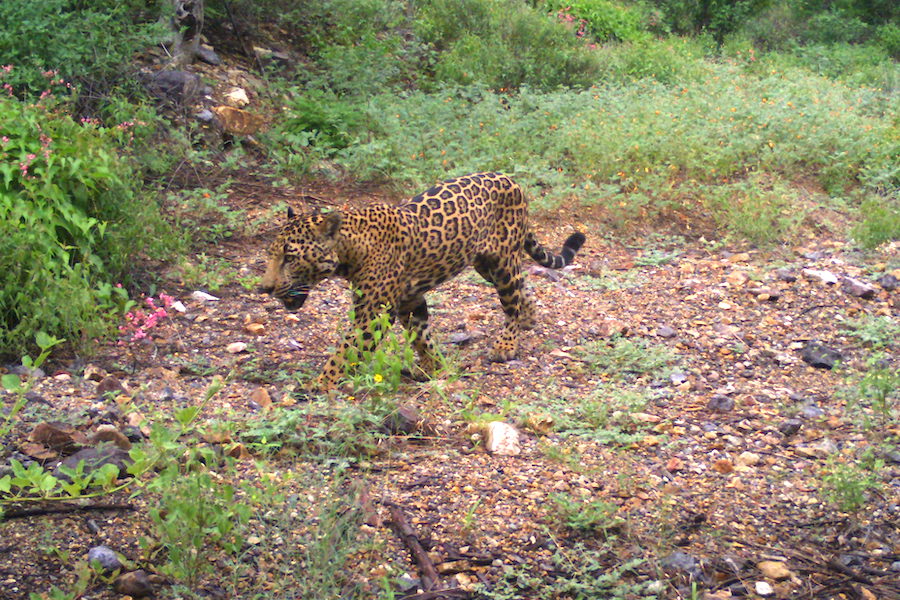
Four Reasons to Support NJP April 3, 2018
The jaguar Libélula celebrates her six-year anniversary on our motion-triggered cameras this month. She is the reigning matriarch on the Northern Jaguar Reserve, a place distinguished by its female jaguars. These jaguars represent the future for this endangered population; here are four reasons to support NJP today.
Read More
One. We have photographed 10 different jaguars on the reserve and neighboring Viviendo con Felinos ranches since this time last year. This includes Libélula and the new jaguar Luisa. Both recently suggested they might have cubs nearby.
Two. Our Viviendo con Felinos project more than doubles the size of the protected area. The feline results on these ranches continue to break records, with two new jaguars so far this year. Watch the award-winning documentary “Rancheros del Jaguar” and meet the Viviendo con Felinos ranchers here.
Three. Our youth activities are overflowing with participants. Each of our Eco-Guardian outings this year has had dozens of kids working together to set up motion-triggered cameras. These events are fun, popular, educational, and get kids out in nature.
Four. Our reserve biologists recently retrieved 170 videos of two playful mountain lion cubs with their mom. View highlights here and here. We cannot think of a better way to illustrate the value your donations have and, even more so, to express thanks for your contributions. Many thanks for your support on Arizona Gives Day!
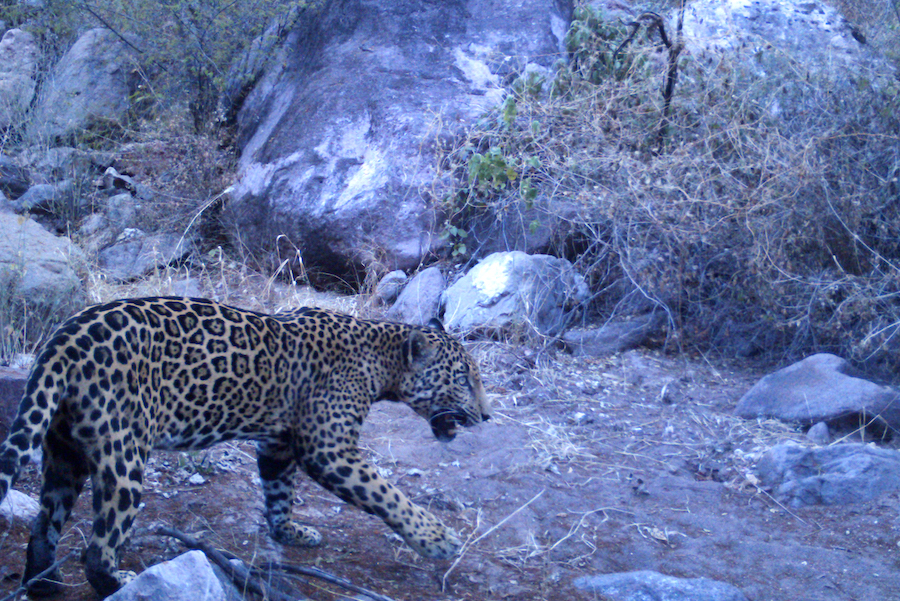
Viva Los Jaguares March 2, 2018
Over the weeks of voting during Summit Hut’s Banff grant contest this winter, we were consistently touched that there are so many friends of the jaguar who want to help. The excitement and enthusiasm our supporters have shown in promoting this contest and asking friends to join us to save the northern jaguar helped NJP win much-needed funding.
Read More
Our thanks to Summit Hut for their commitment to protecting the outdoors and for selecting NJP as a finalist for their Banff grants. Each year, Summit Hut hosts the Banff Mountain Film Festival, two nights of inspirational films with an environmental message. They then donate a portion of the ticket sales back to the community. We appreciate Summit Hut’s encouragement of safe, responsible outdoor exploration and even more so their deep connection to local organizations that preserve, educate, and enhance our wild places.
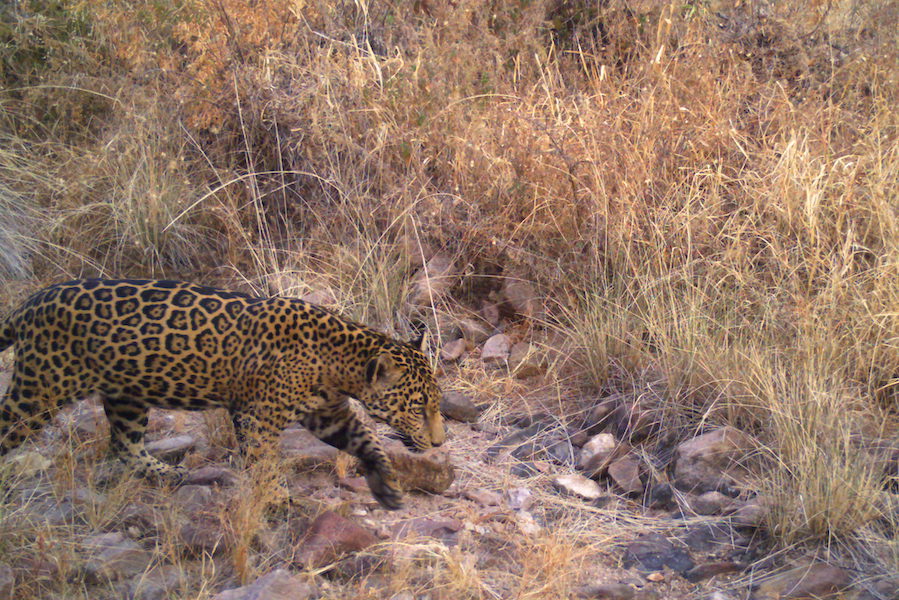
Round Up at the Co-op January 4, 2018
Throughout January, when you Round Up your purchases at the Food Conspiracy Co-op in Tucson, your spare change will directly support NJP and our conservation work. Every Round Up donation at the Food Conspiracy this month protects and nurtures jaguars and the abundance of wildlife found on the Northern Jaguar Reserve and surrounding Viviendo con Felinos ranches. Thanks to the Food Conspiracy for their support and for being our source of nutritious, local, and sustainably produced food.
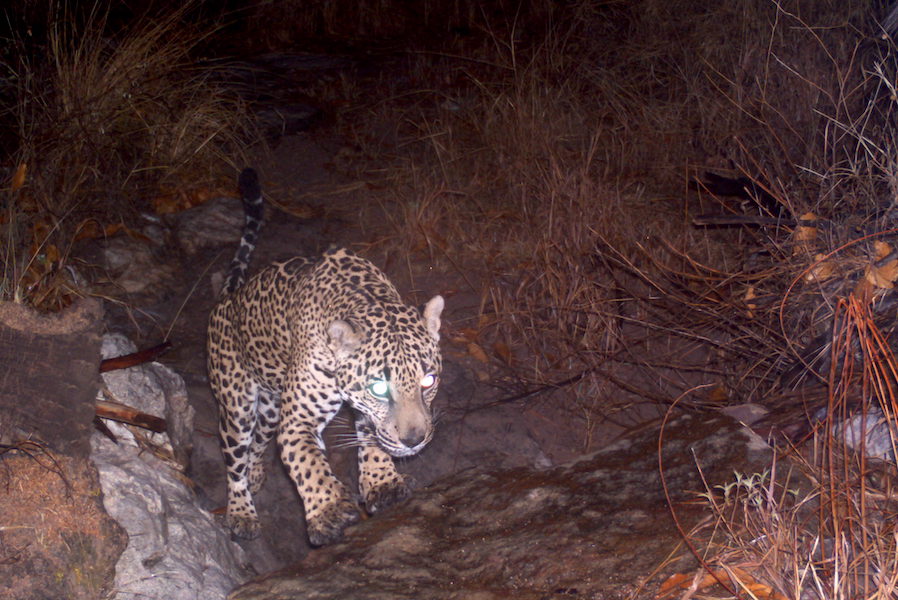
A Year of Accomplishments December 28, 2017
This is Chiltepin, one of the Northern Jaguar Reserve’s resident males. With his steady presence, Chiltepin has become an old friend. He was photographed more than any other jaguar this year, and he has found a safe place to roam because of friends like you. Here is a partial list of our year’s accomplishments.
Read More
• Increased protected habitat on the reserve and neighboring ranches to 200 square miles.
• Enrolled 14 ranches in Viviendo con Felinos, a record number of which photographed jaguars.
• Distributed $37,500 in photo awards, an average of $0.50 per acre protected under signed agreements, which helped ranchers meet day-to-day needs.
• Commemorated the 10th anniversary of Viviendo con Felinos with a celebration four times the size of the previous year – and four times as festive.
• Built gabions on five ranches to address water scarcity and rehabilitate overgrazed areas.
• Engaged 250 youth as conservation ambassadors with fun, interactive activities, such as nature hikes, tree plantings, and mural painting.
• Trained young Eco-Guardians in camera operation and placement, and sent them out to install cameras on their own.
• Projected larger-than-life jaguar photos onto both sides of the U.S.-Mexico border wall to bring attention to how this barrier impedes the flow of life.
Today, your support is needed to continue this upswing of local involvement, reduce hostilities toward carnivores, and counteract threats from the illegal poaching and poisoning of wildlife. Every donation we receive protects and nurtures these rare, beautiful, and important creatures.
All gifts from new, first-time donors will be matched 1:1 thanks to a generous challenge grant. If you have not previously made a contribution, now is your chance to double your impact. Thank you for your support!

Meet this Month’s Jaguars November 28, 2017
Meet the jaguars in this month’s batch of motion-triggered camera photos. The two on the left are new individuals on the Northern Jaguar Reserve and Viviendo con Felinos ranches. The third image is the female jaguar Suki, one of our longest recorded individuals at 5 years, 2 months. On the right is Libélula, an even longer-term resident whose hanging belly in the latest images suggests she might be pregnant.
Read More
When our field staff realized there were two brand new jaguars within days of one another, their hearts started to beat faster with excitement. In addition to the sightings of Suki, Libélula, and other old friends, we have had a total of four new jaguars this year.
The new jaguars that have appeared and those long-time residents directly benefit from your contributions today, on Giving Tuesday, and every day. All gifts from new donors will be matched 1:1 thanks to a generous challenge grant. If you have not previously made a contribution, now is your chance to double your impact!
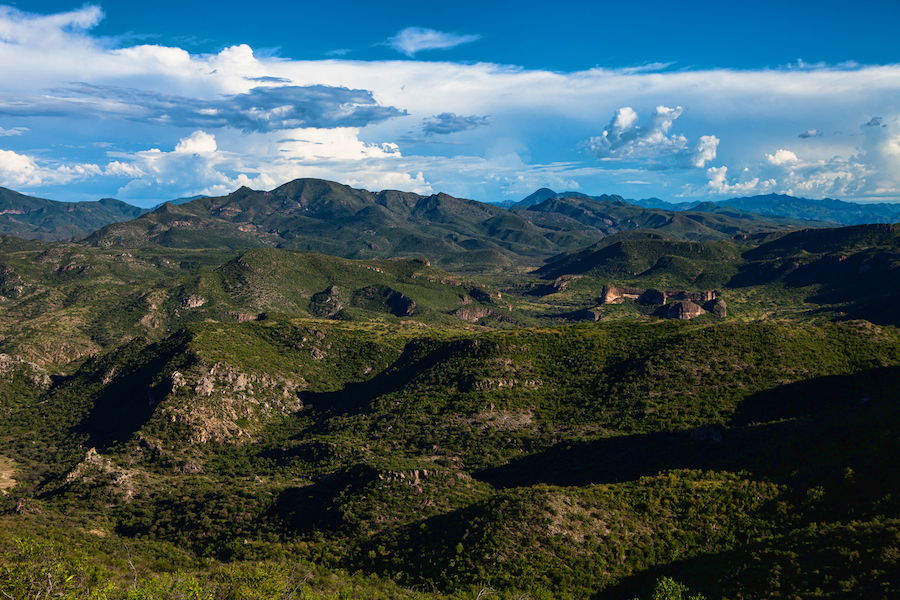
USA Today: “The Wall” Podcast October 9, 2017
At the Northern Jaguar Reserve: “We saw the core habitat of this population that now and then makes its way into Arizona. I’ve been in some remote places before, but it feels like you are in the middle of nowhere. The sky is not much different from Arizona; it is a little bit wetter. It is clear skies at night, millions of stars.
Read More
“We did not happen to hear a jaguar from camp, but they have heard it before. They’ll talk about how you can be up on one of these mountains and look across six or eight other peaks that have no one on them. Basically as far as you can see, you are looking at mountains that are uninhabited by anything but deer and jaguars.
“People don’t realize that jaguars belong in the Southwest. A lot of people are surprised, even Arizonans are surprised, to hear that they ever lived here. Certainly a lot of Americans are surprised to learn that there are jaguars anywhere in the United States. Regardless of how you feel about the Endangered Species Act or what’s more important, national security or biological diversity, I think it is important to be aware that there are trade offs. You can choose whichever you like. But in this particular case, a continuous wall that blocks humans is also going to block jaguars and that would mean that there will not be jaguars in the United States.”
– Words by Brandon Loomis, excerpted from USA Today’s “The Wall” podcast. Listen to the entire episode here.
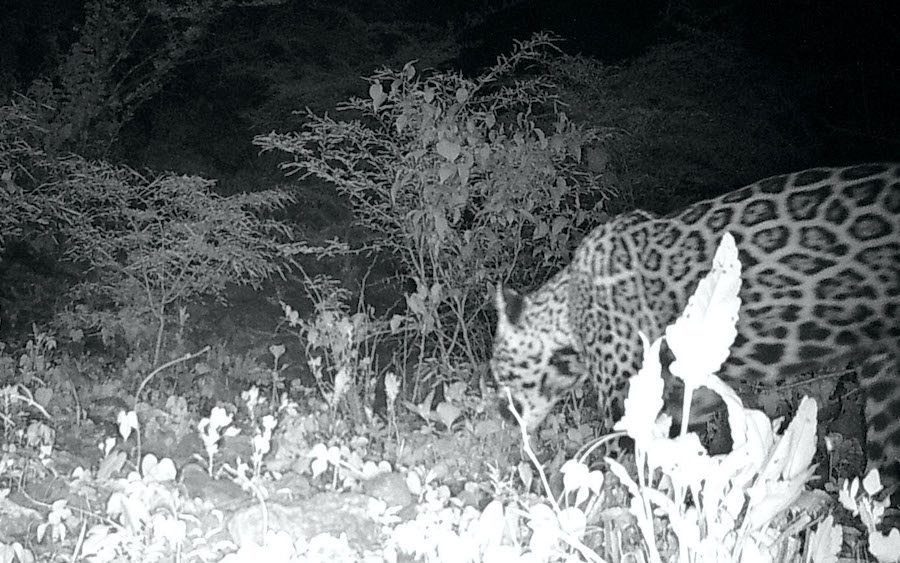
A Brand New Jaguar August 28, 2017
“It would make my year to see a mountain lion in the wild; it would make my life to see a jaguar in the wild – here’s hoping there will be more jaguars to see.”
Read More
We received this heartfelt note from a new supporter who lives near the U.S.-Mexico border. You can imagine how much this touched us. And it reinforced our commitment to the vast, rugged landscape of the Northern Jaguar Reserve that protects the world’s northernmost breeding jaguar population.
With the onslaught of negativity our world is experiencing right now, we are lifted up by the steady stream of jaguar images from the reserve and neighboring Viviendo con Felinos ranches. Last week, our vaqueros came back to town with the latest batch of photographs from our motion-triggered cameras. They eagerly shared the news: One of the memory cards contained a thrilling photo. A brand new jaguar.
This was the second new jaguar in a matter of months on the Viviendo ranches, along with other jaguars who have become old friends and an unprecedented number of bobcats, mountain lions, and ocelots. In less than a year, the Viviendo ranches have far surpassed expectation with 650 feline photos combined.
We also retrieved photos of a female jaguar not seen since 2014. Libélula was in our first videos of a jaguar pair, was the mother of the cub Pedro, and is one of our longest documented jaguars on the reserve. Her safe return brings us great joy and excitement.
We cannot share every photo with you here, but we can say thank you. Thank you for sharing a passion for wildlife and wild places. By supporting the Northern Jaguar Project, you are having a direct and positive impact on jaguars and the habitat on which they depend.
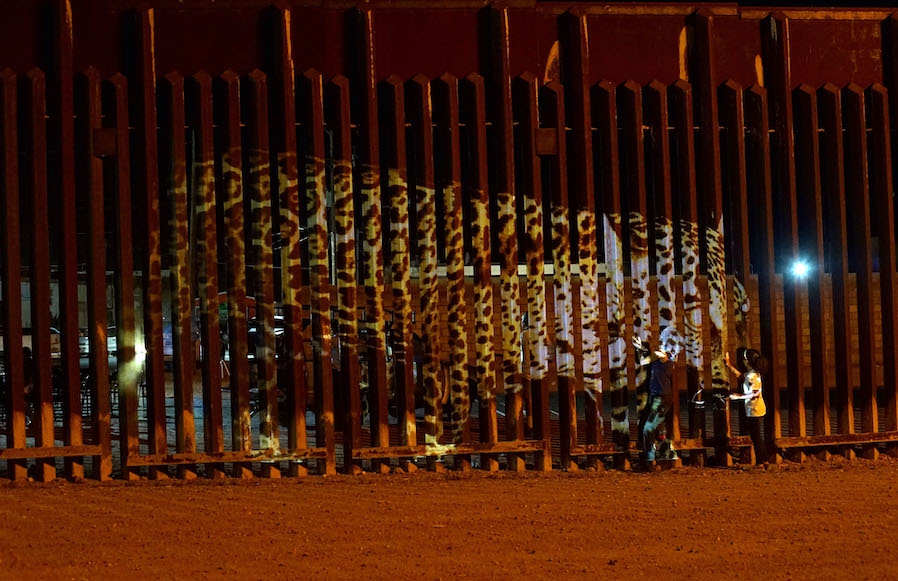
Un-Fragmenting / Des-Fragmentando May 31, 2017
Un-Fragmenting / Des-Fragmentando: Reuniting Culture and Ecology in the Borderlands transforms the U.S.-Mexico border wall from barrier to backdrop, projecting jaguar and other wildlife images from the Northern Jaguar Reserve and neighboring Viviendo con Felinos ranches directly onto the rusted iron construct.
Read More
Through binational cultural engagement, community education, and digital projection, ecological artist Lauren Strohacker and collaborators envision removing barriers to ensure the survival of a wide diversity of species, including the iconic jaguar.
On May 12, residents of Douglas, Arizona, and Agua Prieta, Sonora, gathered while larger-than-life images of native wildlife, including jaguars, appeared on both sides of the U.S.-Mexico border wall. The projections showed how animals in this region are negatively impacted by the current border wall and proposed expansions. The wall interrupts a crucial migration corridor and destroys habitat with a physical barrier, roads, and high-powered lighting, endangering these species and their fragile ecosystem.
The mayors of Douglas and Agua Prieta shook hands through the border wall before they spoke. Each expressed a passionate and collaborative vision for the future where borders are not physical barriers but celebrated spaces that protect humans, wildlife, and their shared environment.
Lauren Strohacker delivered the final speech of the evening, explaining her inspiration and vision for Un-Fragmenting / Des-Fragmentando to broaden the conversation about the border wall and connect culture and ecology through creative, community-based projects.
She ended with a question: “How will we remember tonight? Will we look back on this event as the last stand of the northern jaguar or as the beginning of the greatest ecological comeback story of our lifetime?”
View the New York Times video of the event, A Border Fence Blurred Through Art.
– Un-Fragmenting / Des-Fragmentando is in collaboration with the Northern Jaguar Project, Border Arts Corridor, Casa de la Cultura, Conciencia y Educación Ambiental, and with support of the U.S. Border Patrol, city of Douglas, Arizona, and city of Agua Prieta, Sonora.
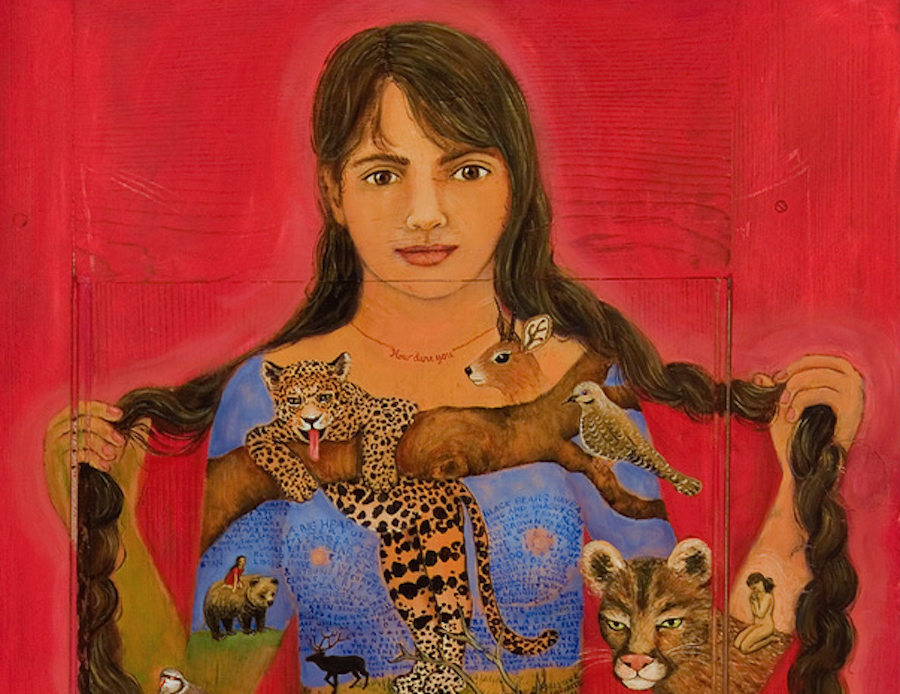
Día de la Madre Jaguar May 4, 2017
May 10th is Mother’s Day in Mexico, and what better time to recognize the female jaguars and cubs found on the Northern Jaguar Reserve. We are celebrating conservation efforts south of the border where the Northern Jaguar Project protects a breeding jaguar population.
Read More
Día de la Madre Jaguar Celebration
Wednesday, May 10th
6:00 – 8:30 p.m.
Mission Garden, 946 W Mission Ln, Tucson, AZ
We have assembled a beautiful collection of jaguar art and handicrafts that we are excited to share with you: masks, carvings, paintings, pottery, textiles, and works featured from throughout the jaguar’s range. We hope you will be inspired to bid and show your support for jaguar conservation in Sonora.
• Silent auction of jaguar artwork and handicrafts.
• Music for the full moon by Tradiciones Taller.
• Preview of larger-than-life jaguar photos to be projected onto the U.S.-Mexico border wall.
• Tastings of traditional regional fare and bebidas.
• Door prizes of heritage trees from Mission Garden.
We look forward to seeing you as we celebrate the female jaguars of the borderlands.
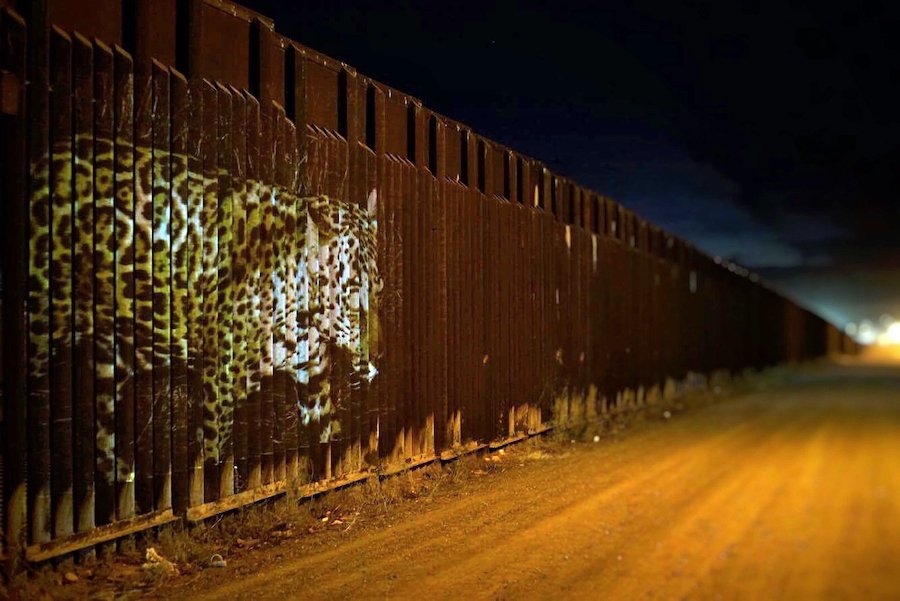
This is the Jaguar’s Moment April 4, 2017
News last month of a new jaguar in southern Arizona captured our hearts and minds. This was the third jaguar sighted north of the U.S.-Mexico border in the last couple of years. Are we seeing these jaguars because motion-triggered cameras are more common? Or is it that our work south of the border is having an impact?
Read More
With your support, we are safeguarding prime habitat in Sonora where there is still a breeding jaguar population. If these cats survive, then surely some will move north. This is the jaguar’s moment.
Meanwhile, plans for an expanded U.S.-Mexico border wall would stop wildlife dead in their tracks. Hundreds of miles of physical barriers, roads, high-powered lighting, cameras, and sensors have been around for years. These already wreak havoc on habitat, disrupt wildlife movement and dispersal patterns, block watercourses, and alter fragile ecosystems. More would be worse.
To bring attention to how these barriers impede the flow of life, we are organizing Un-Fragmenting / Des-Fragmentando: An evening of wildlife illuminations on the U.S.-Mexico border. Larger-than-life photographs of jaguars and wildlife from the Northern Jaguar Reserve will be projected onto the border’s metal barrier, momentarily re-opening a critical wildlife corridor.
Today, NJP is participating in AZ Gives Day – a one-day campaign to boost our collective giving power to support Arizona-based nonprofits. Your contribution will help this public art installation reconnect the wild places of the borderlands. Ultimately, we want to create passageways where a jaguar could safely saunter northward from the reserve to reoccupy habitat in Arizona, New Mexico, or even Colorado.
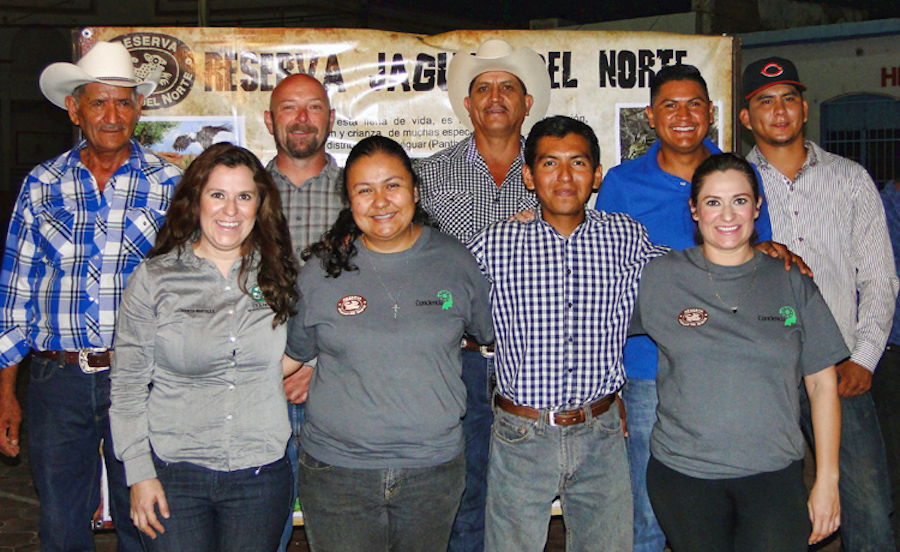
Meet Our Field Team December 30, 2016
This is who you support when you make a donation to NJP. They are making a difference every single day in the communities and habitats where jaguars live. They mirror the strength and grace of the jaguars they protect, and they are crucial for building cohesion and learning where threats and hostilities to large carnivores persist.
Read More
Our field staff are the reason we can bring you inspiring year-end treats you will see nowhere else. Here are a few of our favorite results this year:
• Our Viviendo con Felinos project reached record-breaking heights with 12 ranches receiving a total of 610 photo awards for bobcats, mountain lions, ocelots, and jaguars.
• Ocelot photos doubled on the ranches in 2015, and then doubled again in 2016 with 20 individuals. Like the jaguar, ocelots are endangered in the U.S. and Mexico.
• We worked with more landowners, some very hostile toward carnivores, and kept them from setting out poison or illegally hunting wildlife.
• The newly elected, progressive local government worked with us to promote conservation, outreach that is essential for jaguar survival.
• We saw the return of two jaguars, Elvis and Suki, who were among this year’s most frequently sighted individuals. The presence of these and other jaguars tells us we are providing the safe haven that wildlife desperately needs. We need to keep moving in this direction.
These results are the building blocks for our upcoming activities and are only possible because of your support. With a dedicated group of supporters that numbers in the hundreds, not thousands, we have made huge strides. The Northern Jaguar Reserve and Viviendo con Felinos project are having a positive impact on this community, the northern jaguar population, and the unparalleled biological diversity found in this region.
We have the vision, a team we can depend on, and the passion to help jaguars. We pride ourselves on being small, nimble, and effective, and we are grateful for your tax-deductible, end-of-year contributions to be put toward working with those living in jaguar country, to support the reserve, and its future expansion. Many thanks for your support.
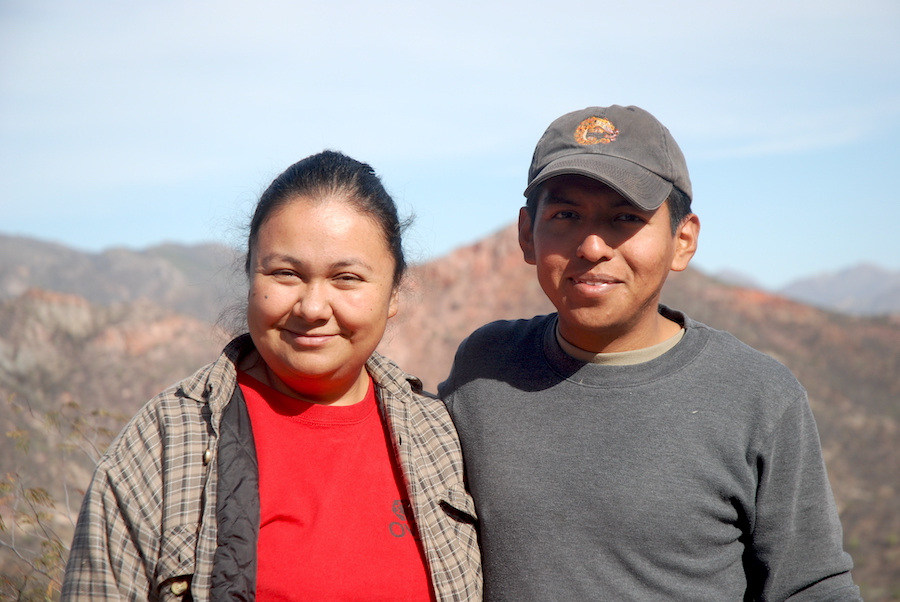
Letter from Our Reserve Biologist December 10, 2016
I am so happy to be living in Sahuaripa again. When I accepted a position in 2008 as one of the first jaguar guardians on the Northern Jaguar Reserve, I did not realize the huge commitment my now-husband Miguel and I were undertaking.
Read More
We saw the reserve and Viviendo con Felinos project become established and grow. We also came to know many individual jaguars. While we did not set out to have favorites, Perrito, El Inmenso, and Corazón each held a special place in our hearts. We still remember the day we heard a loud roar, silence, and another roar at the bottom of the canyon. That was El Inmenso.
After four years, we felt we needed more preparation and education to really help this endangered population. We wanted to help more than we knew how in that moment.
I have always thought that science is essential for an effective conservation plan, so Miguel and I left to pursue our graduate studies. He obtained his master’s degree based on ocelot research on the reserve. I was able to use the reserve’s jaguar records for my Ph.D. studies, which helped me understand a little more about this beautiful species. But I also realized that we need to expand studies because we cannot protect a single species like the jaguar without consideration for all of the other species it interacts with.
Studying jaguars at the university, even without being on the reserve, was like continuing to work for this project. I always knew that my results were going to be used for jaguar conservation, and it did not take long for Miguel and I to decide to come back to the reserve when we finished school.
It has been great to see old friends, vaqueros, and ranchers who still remember us after several years. It is also great to see how the reserve and Viviendo con Felinos project have grown in our absence.
Miguel and I have a stronger commitment today than when we first arrived eight years ago, and we know the challenges and responsibilities are bigger. We also know that day-by-day more people in Sahuaripa understand the importance jaguars have for the ecosystem and commit to protecting them.
Having our home here allows us to get closer to the community. We can be in direct contact with the Viviendo con Felinos ranchers, we can listen to their needs and concerns, and together, we can plan the best strategies for their ranches and also for the jaguar.
I always have in my mind Caza, Chiltepin, Elvis, Francisco, Suki, her cub Carmen, and all the jaguars that roamed the area this year and need our protection. I also think about the 50 jaguars we have detected over the last decade and carry them with me. Thank you for helping us help jaguars.
We look forward to sharing our adventures with you!
– Carmina Gutiérrez González, Ph.D., Northern Jaguar Reserve Biologist
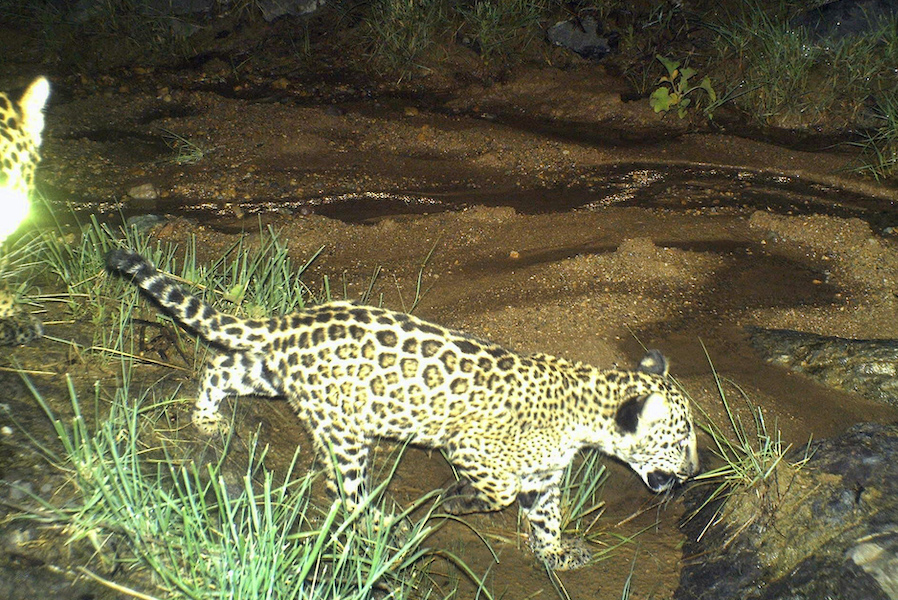
A Jaguar Cub on Camera November 29, 2016
When our jaguar guardians hike to camera sites on the Northern Jaguar Reserve and surrounding Viviendo con Felinos ranches, they cover a vast, rugged landscape that spans 115,000 acres. They never know what they will discover on the cameras. They hope for a jaguar. Once, they heard one roar nearby. Only four times in the last decade have they retrieved a photo of a jaguar cub.
Read More
Jaguar cubs do not move away from their den often, which makes glimpses rare. Earlier this year, we had pictures of a female jaguar that suggested she was a mom. It was not until months later that we saw her traveling with her five-month-old cub. This image invokes awe, reverence, possibility. It inspires, and more than anything, gives us hope for the future. It tells us we are providing the safe haven that wildlife in this region desperately needs.
With your support this year:
• Our Viviendo con Felinos project reached record-breaking heights with 600 feline photo awards distributed… including an astonishing number of ocelots.
• We worked with more landowners, some very hostile toward carnivores, and kept them from setting out poison or illegally hunting wildlife.
• We engaged in activities with the newly elected, progressive local government to promote conservation and extend protections for jaguars.
• We started to get kids out in nature, planting trees, painting murals, and learning about local wildlife.
Today is Giving Tuesday, a day designed to support the causes that matter most. Each donation we receive helps create a refuge for mother jaguars and their cubs. We invite you to support our collaboration with youth and adults to reduce human-wildlife conflicts, to contribute to the guardianship of the reserve, and to its future expansion. Thank you for your past support and all that you continue to generously give.
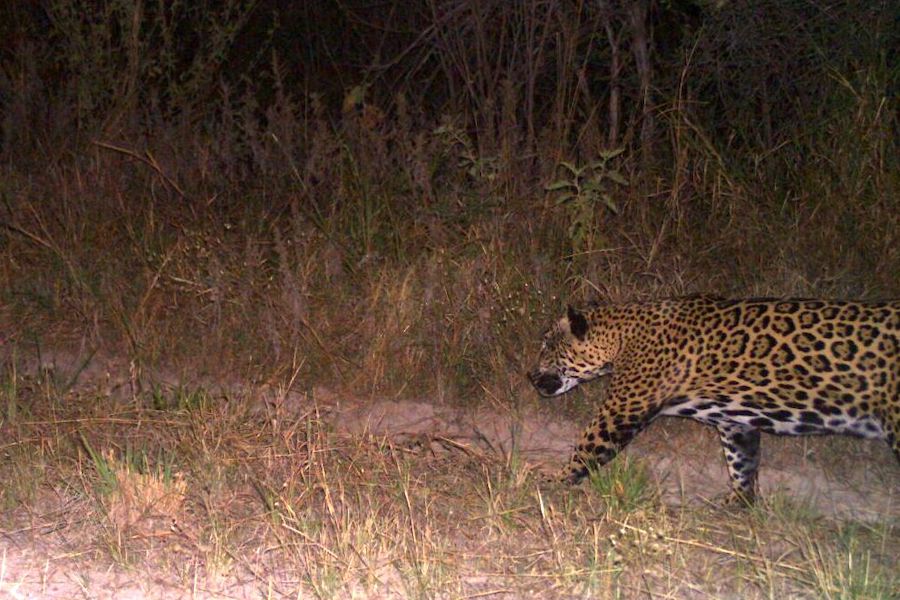
The Return of Elvis April 5, 2016
A young male jaguar, named Elvis, first appeared on the Northern Jaguar Reserve in 2013. He was not seen again, and all assumptions were that he was a dispersing juvenile who had to find territory outside the scope of our motion-triggered cameras. We did not know if he survived.
Read More
Then last month, we retrieved photographs of Elvis for the first time in two and a half years, taken on the reserve near the boundary with two Viviendo con Felinos ranches. How he eluded documentation over such an extended period is a mystery. Yet for now, there is a deep joy felt by everyone working on the reserve and Viviendo con Felinos ranches that he continues to roam this vast, rugged landscape 125 miles south of the U.S.-Mexico border.
Elvis’ return shows us that we are moving in the right direction, providing the safe haven that wildlife in this region so desperately needs.
Today, NJP is participating in AZ Gives Day – a one-day online campaign to boost the collective giving power to support local nonprofits. You do not have to live in Arizona to participate. Your contribution will help our Viviendo con Felinos project create an expanded safe zone for jaguars and further reach schools and livestock organizations in the region where jaguars roam.
We are grateful for all of you who make up our base of support; our work would not be possible without you. On behalf of Elvis and all the jaguars who call the reserve home, thank you!
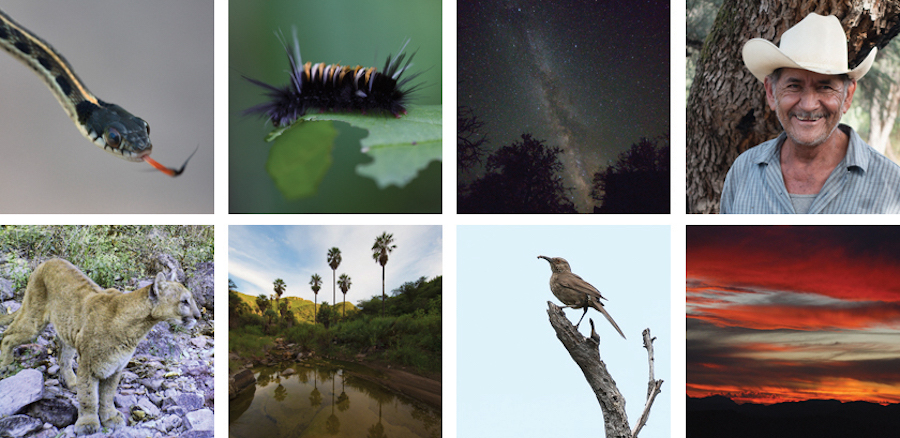
The Survival of the Jaguar December 31, 2015
Our work is possible because of you. Thanks to your generous support, the Northern Jaguar Reserve encompasses 55,000 acres and is home to jaguars, ocelots, and an amazingly rich diversity of species. As we look back on 2015, we recognize how important the reserve has become as it grows and matures as a model sanctuary for wildlife in a region where poaching and poisoning remain ongoing threats. The northern jaguar’s survival is in all of our hands.
Read More
In the coming year, along with the guardianship of the reserve, we will:
• Work side by side with local ranchers to create an expanded safe zone for jaguars traveling through this remote, rugged landscape. Four new ranches want to join our groundbreaking Viviendo con Felinos project.
• Spread our educational outreach to schools and livestock organizations in the region. We are getting kids outdoors and showing them that it is exciting to live in a place where jaguars still roam.
• Take steps to develop a better scientific understanding of the western hemisphere’s largest feline and its habitat. Our comprehensive planning process will bring together scientists and conservation planners from the U.S. and Mexico.
The Northern Jaguar Project has come to a crucial point in our development where we need to reach out to a much larger audience and expand our sphere of influence. That is where you come in. Big leaps like these can only be made with your support. On behalf of all the jaguars who call the reserve home, thank you.
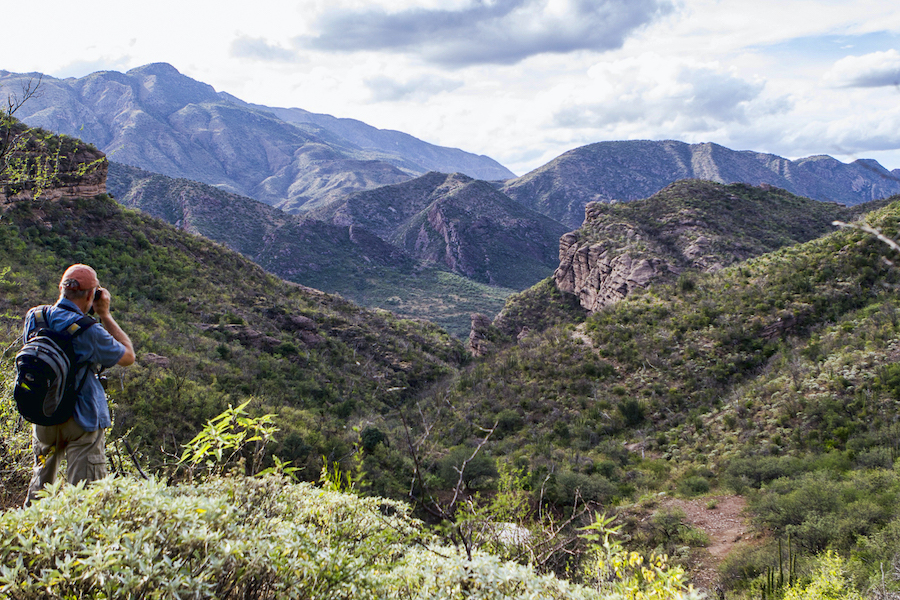
An Exciting Year to Support the Jaguar April 7, 2015
Your support helps us expand the protected habitat and safeguard jaguars from illegal poaching, habitat loss, and other threats. Here is a sample of what we have accomplished so far this year.
Read More
We enrolled a prominent, influential rancher who had a long track record of spreading anti-carnivore sentiments into our Viviendo con Felinos project. Within a month, he was rewarded with his first jaguar photograph, proving that his property is an important habitat for jaguar conservation as we continue to unseat long-held intolerances of predators.
We hired our first fulltime reserve manager. Originally from Chihuahua, Randy Young has a strong family background within the outdoor and ranching communities. As he settles into his new role, Randy will be critical in learning where ongoing threats to jaguars persist and in building cohesion for local wildlife conservation.
We are closing in on raising the balance of funds needed for the final Bábaco payment. With significant jaguar documentation, extensive wildlife sightings, and an abundance of perennial water, the 5,000-acre Bábaco ranch is currently our top conservation priority. We hope to complete the final steps of the purchase this spring.
Today, NJP is participating in AZ Gives Day – a one-day online campaign to boost the collective giving power to support local nonprofits. You do not have to live in Arizona to participate, and your contribution will go toward the Bábaco purchase and ongoing reserve guardianship. We have a challenge grant right now to fully match all donations from brand new donors – so if you have never donated to NJP, you can double the impact of your gift.
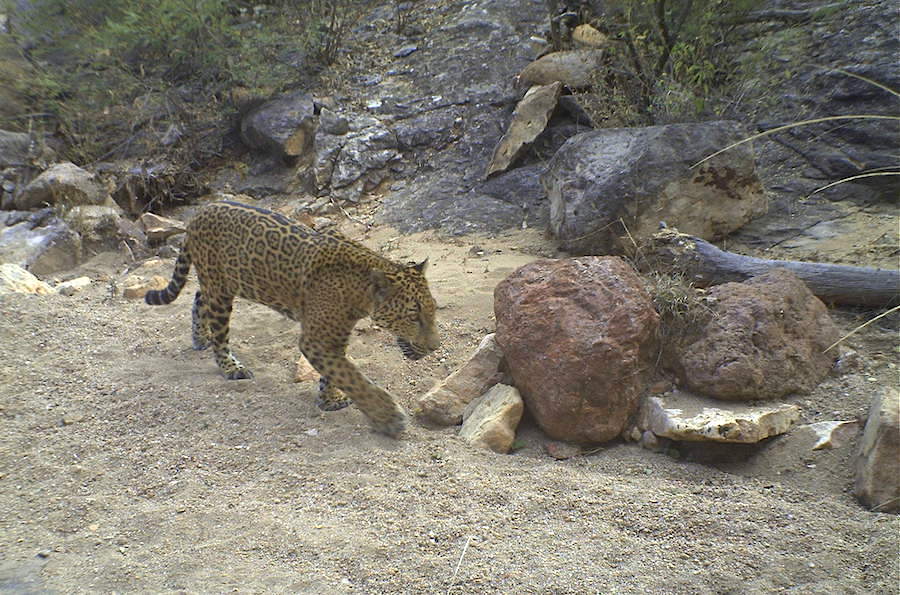
Big Projects for the Year Ahead December 31, 2014
Looking back at 2014, the Northern Jaguar Project sends our heartfelt thanks for your generous outpouring of support. We have two big projects in the coming year: expanding the Northern Jaguar Reserve and building our Viviendo con Felinos project.
Read More
Earlier this month, we made the down payment on the 5,000-acre Bábaco ranch. Bábaco is a hotspot of jaguar activity, with 11 individuals photographed in recent years. We must still raise $145,000 for the second and final Bábaco payment.
We work with 10 ranchers who have signed agreements to not harm wildlife. We place motion-triggered cameras on their properties, and they receive monetary awards for all feline photographs. One prominent local rancher who has been a critic will join Viviendo con Felinos next month. His ranch is 17,000 acres, which is nearly half the size of all the other ranches combined.
We appreciate what you are able to continue to give to widen the circle of protection for the jaguar. Our work would not be possible without you – thank you for your support!
If you have never before donated to NJP, you can double the impact of your gift, thanks to a special 1:1 matching grant for all new donors.
Video Captures Rare Jaguar Footage September 16, 2014
Two years ago, we featured video footage from the Northern Jaguar Reserve of two romantically inclined jaguars walking together through an arroyo. Then last year, our cameras captured images of their six-month-old cub heading confidently into the night.
Read More
Now, much more exciting, we have retrieved an extremely rare and candid video of two jaguars, Caza and Osman, mating on the reserve. While it is not National Geographic quality, and it is only a 25-second clip, we are amazed that our camera was in just the right place at that moment.
This video provides a ray of hope following the tragic death of the female jaguar Corazón earlier this year. We imagine a new cub should be starting to wander around the reserve this fall.
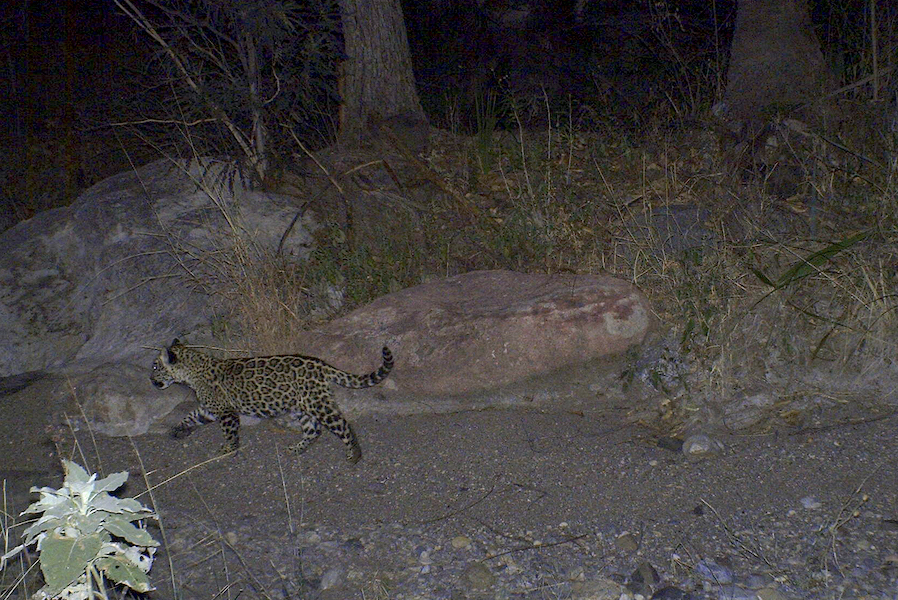
Looking Back at 2013 December 31, 2013
This year, we retrieved 18 photographs of jaguars on the Viviendo con Felinos ranches – including the first cub. Establishing a safe-haven for mothers and cubs is the main reason we established the Northern Jaguar Reserve, and why our collaboration with neighboring ranchers is so essential.
Read More
Our cameras have photographed a total of 45 individual jaguars on the reserve and neighboring ranches. This summer, we surpassed 500 total jaguar photos to date. In addition to “Pedro” – the six-month-old cub named after beloved NJP board member Peter Warshall – highlights from the year’s photos include five female jaguars and five new males.
Other highlights include an unprecedented number of felines on the ranches. This year’s 259 Viviendo con Felinos photos surpassed the total number of feline photos for any of the previous five years, and nearly half of the participating ranches recorded all four cat species – jaguar, ocelot, mountain lion, and bobcat. This generated more than $24,000 in awards for our rancher neighbors.
We enrolled a new ranch in Viviendo con Felinos, where the owner had been considering lethal alternatives to end mountain lion-related livestock losses. He is the relative of a rancher who has been spreading anti-carnivore sentiments locally, creating an important connection to a prominent ranching family.
We led a crew of local workers from Sahuaripa to build gabions on more than 200 acres of eroded, heavily grazed habitat on the reserve and Viviendo con Felinos ranches. These gabions are permeable rock micro-dams that slow stream flow, retain soil moisture, raise the water table, and counteract the prolonged regional drought.
We urgently need to stop the spread of highly invasive and highly flammable buffelgrass. This summer, we targeted newly sprouted grass in heavily infested priority areas, and we plan to repeat this work over a multi-year period to achieve a high kill rate and restore native vegetation.
We hosted a series of community events and brought adventure trekker John Davis to Sahuaripa for the launch of his 5,000-mile journey, TrekWest – a trek from Mexico to Canada that showcased North America’s last remaining wild places – places like the reserve.
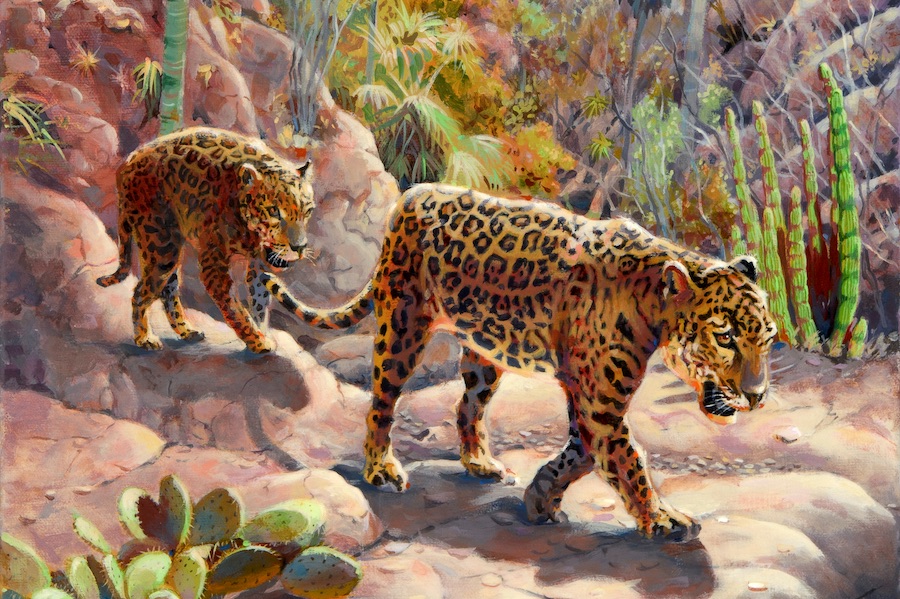
Tigres del Desierto Art Raffle August 20, 2013
Barry Sapp’s original 17 × 13-inch painting, Tigres del Desierto, is based on video footage from the Northern Jaguar Reserve of two romantically inclined jaguars walking together through an arroyo. Later photographs from the reserve’s motion-triggered cameras revealed the female jaguar was pregnant. In April 2013, our trip cameras photographed her six-month-old cub heading confidently into the night.
Read More
Purchase raffle tickets for a chance to win this incredible painting and celebrate the reserve as a birthplace and sanctuary for female jaguars and their cubs. Your contribution directly supports NJP’s jaguar conservation efforts. Raffle tickets are $10 each or 6 for $50.
Then join us for a live raffle of Tigres del Desierto. Music by award-winning troubadour Kevin Pakulis. Bacanora tasting courtesy of Pueblo Partners Trading Co.
Friday, October 25
5:00 – 8:00 p.m.
Jane Hamilton Fine Art, SW Corner of Skyline and Campbell
Thanks to the Jaguar Club of Southern Arizona, Royal Jaguar Land Rover Tucson, and Jane Hamilton Fine Art for support.
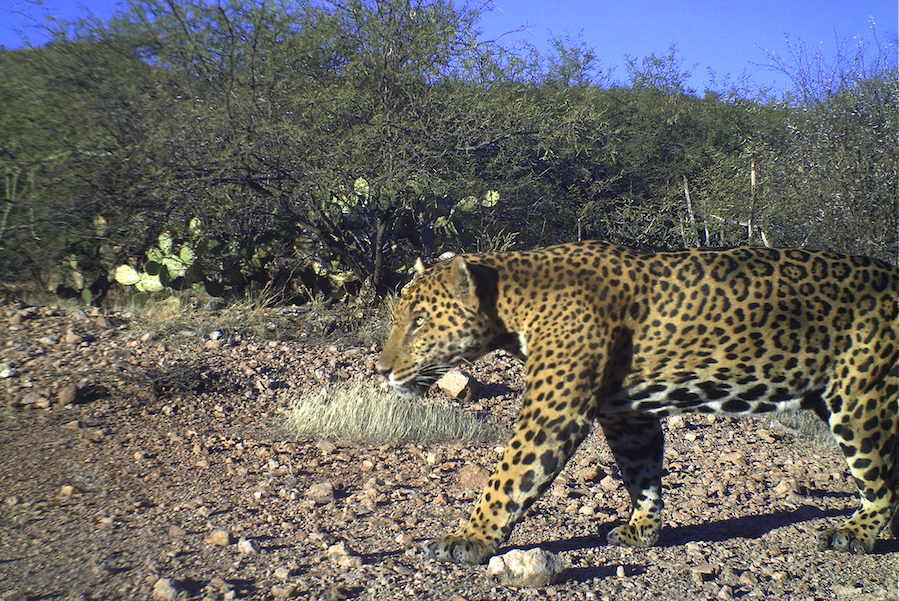
El Inmenso on the Discovery Channel June 5, 2013
The Discovery Channel’s new seven-part series, North America, has captured some of the most diverse environments on the planet. We have been captivated watching the unbelievable footage in the first episodes of this sweeping series, and we are thrilled to play a small role in what viewers experience in the week ahead.
Read More
In 2010 and 2011, determined film crews relied on our jaguar guardians to analyze recent photographs on the Northern Jaguar Reserve and identify the best locations to obtain video footage. We all knew that this would be an uphill challenge against some pretty sizable odds. We also were excited that if successful, the resulting images would be incredibly powerful, bringing movement to the jaguars we have become accustomed to seeing in still photographs. Using cutting-edge technology, more than a dozen high-definition cameras were set up on the reserve for six months to catch a glimpse of the elusive desert jaguar.
They succeeded! Several clips of the adult male El Inmenso will tell the story of the northern jaguar to this worldwide audience. According to one of the producers, the jaguar sequence is one of the “stand out” moments in the series.
We hope you will join us by tuning into the Discovery Channel this Sunday, June 9. The reserve’s jaguar footage is included in the series’ fifth episode “Outlaws and Skeletons.”
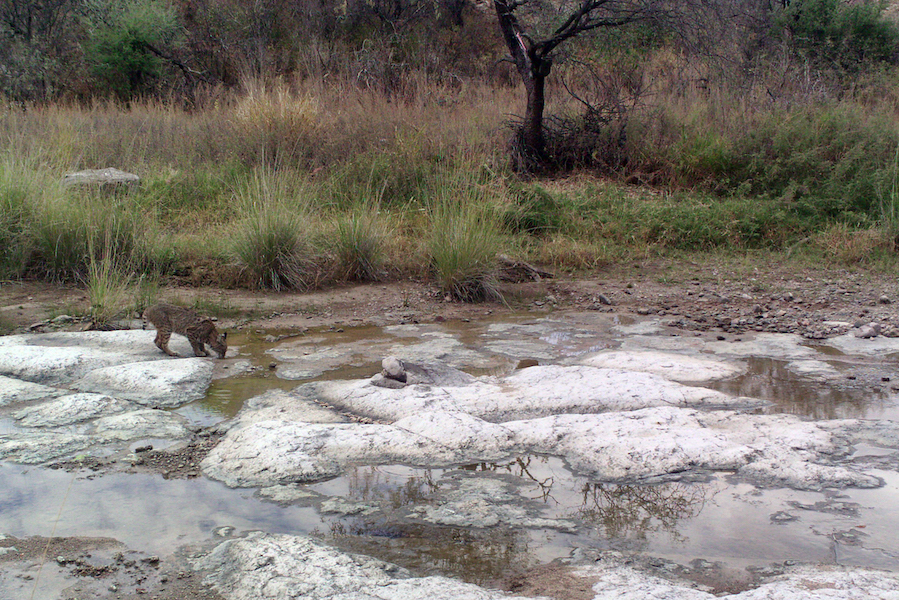
Volunteering on the Reserve May 15, 2013
My first impression of the Northern Jaguar Reserve was a land of thorns, rocks, and dryness in a mad jumble of mountain ranges in all directions. There was a quality of silence I had never experienced before. I feel fortunate that I had enough time for a particular palm tree to become a landmark, to explore arroyos, and time to find new ways to move through the land.
Read More
I was at the reserve to volunteer with restoration work, particularly gabion construction and buffelgrass removal. Gabions are small rock dams used to control erosion. For me, it meant hauling lots of rocks, big and small. We built several gabions at a small ranch along the Río Aros. It was sad to see the damage done by cattle in this area but encouraging to be part of the solution.
Buffelgrass is an invasive species that chokes native vegetation and presents a fire hazard. Off we went, pickaxe on the shoulder, to buffelgrass-covered slopes. For several hours during the mornings and late afternoons, we hunched over, deftly wielding our pickaxes, literally getting at the root of the problem in a slow, methodical progression.
It was a study in contrast. Gabion building was teamwork that required heavy lifting but for a long-lasting result. I compared it to the solitary, never-ending removal of plants that may or may not come back the next season. Every time another clump of buffelgrass was removed, it was another step in the right direction. More often than not, a small native plant would emerge from under the carpet of buffelgrass, free at last, and a living testimony of the usefulness of this back-breaking work.
It was not all work and no play. I was amazed at the bird diversity in this dry winter landscape. I detected almost 100 species, a fascinating mix of temperate and tropical species. It was thrilling to see a wintering hermit thrush in an arroyo where, minutes later, I also watched my first-ever elegant trogons!
My most memorable sighting was of a bobcat. We sat and watched each other for 40 minutes! Its curiosity finally satiated, the bobcat walked away with unmistakable feline grace and quickly disappeared, as if swallowed by the Earth. The other wild cats of the reserve were detected only through tracks, scats, and trail cams. But with some imagination, I was able to “see” a mountain lion squatting and drinking at a small pool, the water protected by big rocks.
– Stéphane Menu, Ph.D., is the station scientist at the Bruce Peninsula Bird Observatory in Ontario, Canada.
Photos: Brendon Kahn

